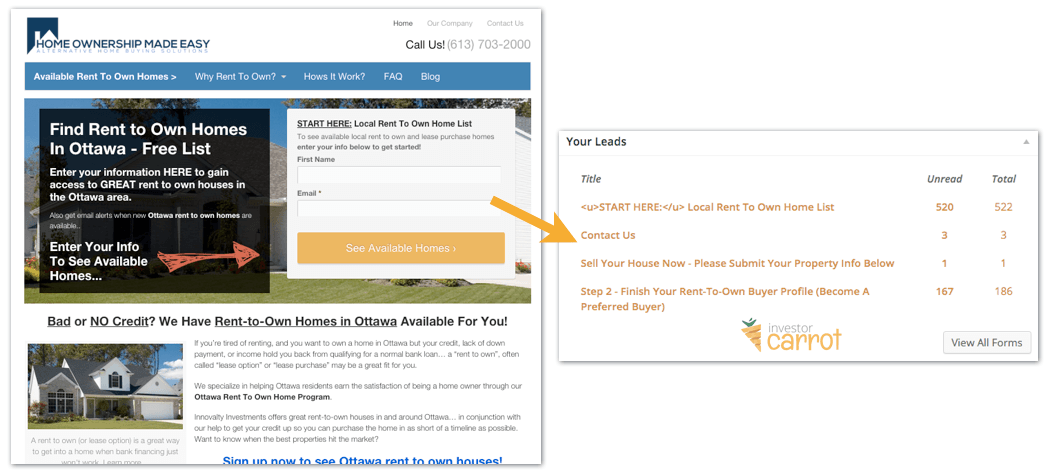20 Steps To Optimize Your Google PPC Marketing Campaigns – Real Estate Investors and Agents 16 Sep 2015 8:28 AM (9 years ago)
Launching a PPC (PayPerClick) campaign can be one of the quickest ways to get your real estate investor website or agent website in front of your ideal prospects. If you haven’t checked out this case study call I did with an investor in Cincinnati recently on his big time return on investment with PPC… you should, it’s posted over on our sister company Carrot’s blog.
But, getting a good return on investment is a lot more than just launching a PPC campaign for motivated house sellers, tenants, or buyers and walking away.
In fact, I’d venture to say that simply launching a campaign, no matter how well it’s setup, and walking away can be an almost guaranteed path to a money suck in your business and your bottom line.
So, in this post we’ll dive into some tips on how to optimize your Google PPC Marketing campaigns as a real estate investor or agent so your PayPerClick campaigns continually give you a higher return on investment over time.
But first…
Should You Outsource Your Google PPC Marketing Or Do It Yourself?
We chatted with a client last week who followed a very good PPC marketing training by a very experienced and legit real estate investor to launch his own PPC campaign… and before he knew it he had spent $1,300 in just 4 days on Google PPC ads with nothing much to show for it because his campaign was launched, but not optimized well out of the gate and he didn’t keep a close eye on it over a long holiday weekend.
Just like that… $1,300 into Google’s coffers in 4 days.
The Managed PPC service in our Carrot Marketplace runs about $350/mo + ad costs… and in this one example, that would have saved this Carrot client hundreds and hundreds of dollars and hours of his time and pulled a higher long-term return on investment.
So, choose wisely because doing your own PPC marketing as an investor or agent does take time, effort, and continual work to be effective. If you don’t have the time or patience but want the result, find a reputable PPC management firm that specializes in real estate.
Ok, if you’ve decided to do your own PPC, congrats!
Let’s dive in and help you optimize your PPC campaigns and pull more profits from the web.
The Benefits Of PPC Marketing For Real Estate Investors And Agents – Why Should You Do It???
PayPerClick marketing is one of the first things we do when we’re going into a new market to generate motivated seller, rent to own tenant buyer, or cash buyer leads.
Why?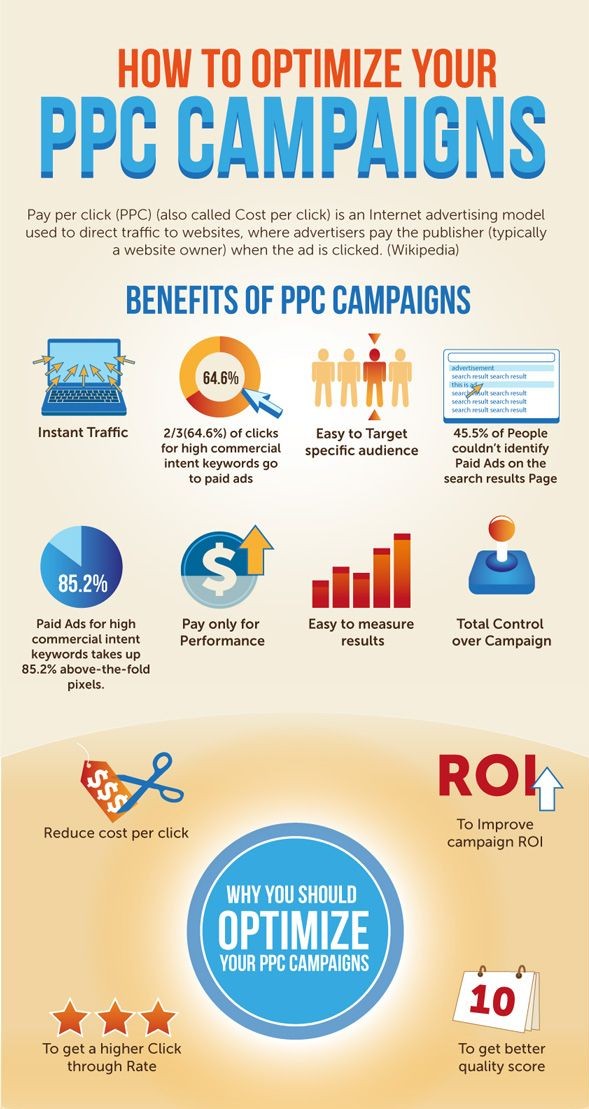
Because like the graphic above shows…
- Instant Traffic: With Google PPC marketing you can have traffic and hopefully leads coming in quickly. Usually within 72 hours of launching a well structured PPC campaign.
- Easy To Target A Specific Prospect: One of the best ways to know that you’re targeting the right person is by getting your website in front of the people who are actively looking for solutions to their problems on Google. “sell my house fast in Atlanta” as an example. That person of course needs to sell fast… that’s a targeted prospect.
- You Only Pay When Someone Clicks Your Ad: Google calls this “pay for performance”. With direct mail, you fork out the money upfront to pay the printing fees and postage with no guarantee that your target prospect will even engage or read your direct mail piece. With PPC marketing you only pay when someone clicks your ad and goes to your website.
- Get Traffic Coming In While You Build Out Your SEO: SEO can take a while to rank well in Google for competitive phrases. So while you’re building up your SEO… you can get traffic and leads coming in today with PPC.
- Easy To Measure: If you set your account and campaigns up correctly it’s pretty darn easy to measure what’s working and what’s not.
So we know that PPC marketing can be really effective for real estate investors and agents… but you may be asking… “How hard can it really be to optimize it? And why the heck do I have to optimize stuff after I get my campaign setup?”.
Well… if you’re not tweaking and refining your Google PPC campaigns to cut out the keywords that aren’t turning into leads and continually optimizing to increase your return on investment… you may as well light your money on fire because a non-optimized PPC campaign is basically doing just that.
So lets dive in and optimize that PPC marketing campaign.
20 Steps To Optimize Your Real Estate Investing PPC Campaigns
Ok, this is where the nuts and bolts comes in.
Of course we don’t have enough space on this blog post to dive into detail about each of the 20 PPC optimization steps, so this post will be focused on showing you what those steps are. We’ll do followup posts here on our blog that dive into more detail on the most important steps… so keep an eye out on our blog and in your email box for more awesome training.
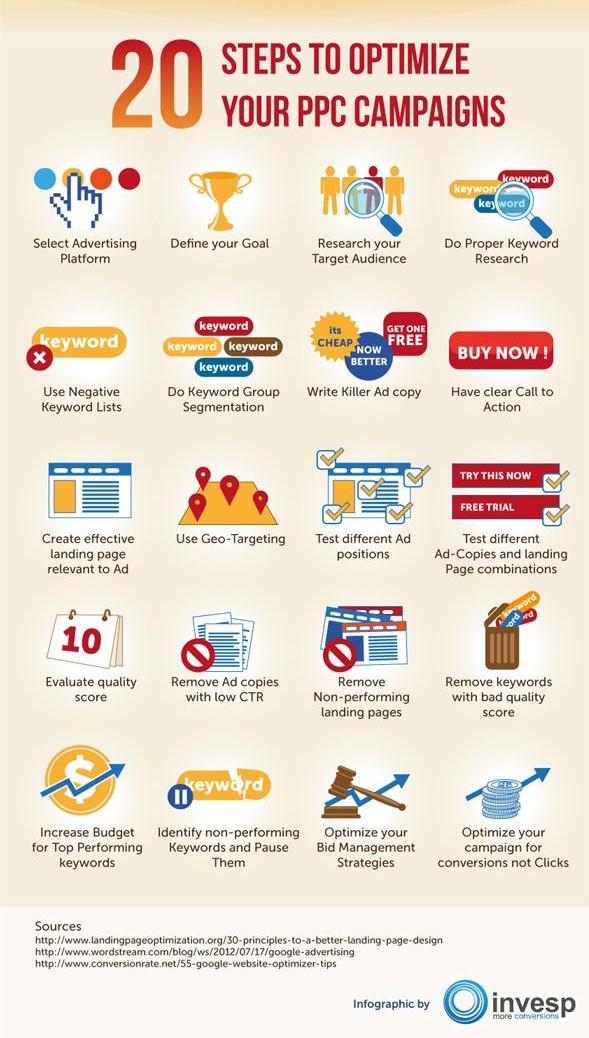
1. Select Your Advertising Platform:
Of course, before you can start doing PPC marketing you need to decide what platforms you’ll use. We always suggest starting with Google Adwords because well over 90%+ of all real estate investing leads we pull in through PPC is through Adwords. The rest is through Yahoo and Bing PPC. So, dive in and start with Google Adwords! Then add on Bing and Yahoo Search Marketing as you go.
2. Define Your Goal:
The biggest mistake investors and agents make when they start their PPC marketing campaigns is… they just start. They launch a campaign but don’t define any real clear goals for what they’re trying to achieve. “Get more leads” isn’t a goal. Make your PPC marketing goals clear and simple. “To generate motivated seller leads at under $60 per lead”. That’ll give you a good goal to shoot for so you know whether your campaign is even successful.
A good goal to start with is defining the cost per lead you’re aiming for and the return on investment you want to get over the long-term.
For most investors a cost per lead of under $90 is solid.
The further below that the better. And as for return on investment… maybe a good one to start is to close your first deal from your PPC seller leads within the first 3-4 months… then ramp it up from there.
You just have to remember that most PPC marketing campaigns don’t start off profitable. It’s the optimization process that makes your PPC campaign profitable as you go… and that can take 1-3 months to really hone down a campaign… and ongoing work from there to keep that consistent. As long as you can make it through the initial optimization phase (the first 1-3 months) your PPC marketing should be really profitable for you over the long run.
3. Research Your Target Audience:
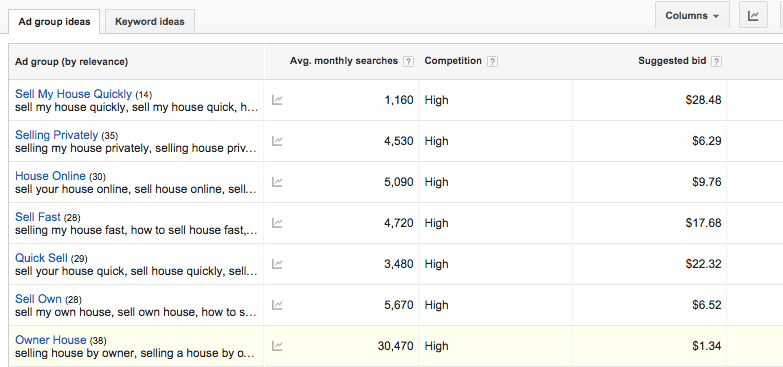
Use the Google Keyword Planner to help you discover what your target audience is typing into Google. It’s crazy the insights you can get in there for how your prospects think and how they search for solutions to their problem. Then serve up ads in front of the keywords that you can help them the most.
Before you launch ads, know who your target audience is.
What problems or needs do they have? What are they searching in Google? What solution are they looking for? What words do they use in their searches? Take all of this info and use it to help build out your keyword lists, ads, and landing pages.
4. Do Proper Keyword Research:
Doing your Keyword Research is one of the most important parts of your PPC campaign.
But use tools like Google Suggest, the Google Keyword Planner, Term Explorer, etc.
Here’s a really good free guide online on Keyword Research that’ll give you a really good start.
A big mistake that we see real estate investors make with their PPC keyword research is they aren’t looking at the intent of the searcher close enough.
Take for example if a seller types in the search phrase “House buyers in Dallas“.
Many people would look at that assume that the person is looking for a company to buy their house. One of those “house buyer” companies. But… what if they’re actually searching for retail house buyers in the Dallas area? If you’re a wholesaler or flipper and you have an ad up for that keyword and the house seller clicks on your ad… they may quickly realize that you can’t help them. Those types of keywords where there is what I call “fuzzy intent” can end up costing you a lot of money. So just make sure the intent of your keywords really focuses as much as possible at the start on the exact people you can help.
This will help you avoid wasting money at the start.
5. Use Negative Keyword Lists:
A “negative keyword” is a word that you can tell Google Adwords to look for… that if it shows up in a Google search… to prevent your ad from showing up to that person in that search.
As an example, let’s say you’re a wholesaler or house flipper and you of course need to buy at a discount. So you may want to add a negative keyword for something like “full retail” in there to prevent any searches that have “full retail” or “full price” in them from showing your ad.
Why? Because this type of person likely isn’t going to sell at a discount. So if someone types in “sell my house in dallas at full price” then your ad wouldn’t show up.
This can keep you from paying for clicks on your ads where the prospects wouldn’t be your ideal client.
6. Do Keyword Group Segmentation:
A big mistake most people new to Google Adwords is they throw all of their keywords into one “Ad Group” in their adwords account.
Heck, I did when I launched my first PPC marketing campaign.
But a really effective way to optimize your ad spend and drive down your cost per lead (also, to better target your ads to specific targets) is create separate keyword ad groups in your Google Adwords account.
Notice We Have Ad Groups Setup For Different Types Of Keyword In This Campaign
Then within each ad group is a whole slew of keyword variations, ads, etc.
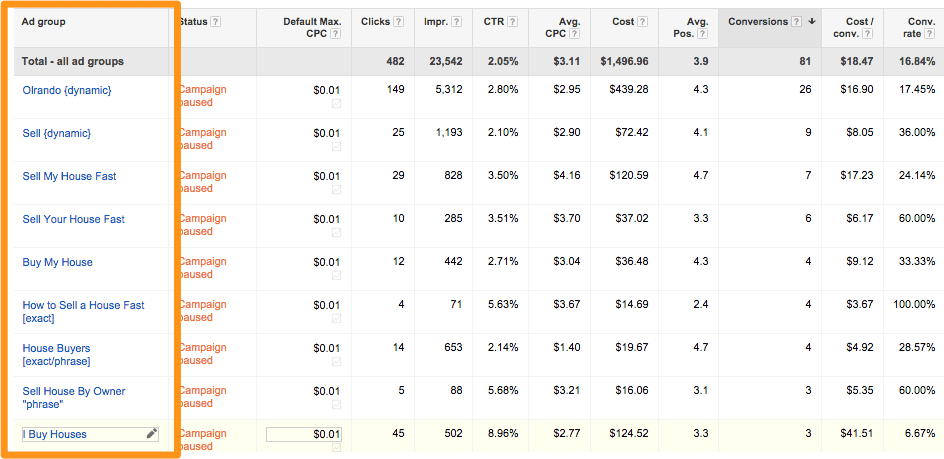
As another example, if you are running ads for motivated house sellers in 10 different cities… create a different keyword group for each location so you can really target those ads for that specific location. An ad targeted for that area coupled with a landing page specific to that area.
This will help the house seller really feel like you’re a local solution and specialize in that area.
But you can also do the same thing with different types of sellers.
Sellers in divorce, in foreclosure, relocating, probate, etc. Build separate keyword groups for each of these and really target in your ad copy and landing pages for those specific people.
7. Write Killer Ad Copy:
Lot’s of people say that phonebook advertising is dead. It definitely will be extinct someday, but people have been saying that phonebook advertising doesn’t work for years and years. (even back when people used phonebooks ;-).
The reason is because local company after local company would say… “Hey, I need a phonebook ad”.
Then they’d look through the phone book and see what their competitors ads looked like… they’d mock up an ad similar to theirs (because that must be working, right?) and put it up there. Then they’d complain because they weren’t getting any calls from it.
But here’s the key, it wasn’t the phonebook that didn’t work… it was that their ad sucked.
It didn’t stand out from their competitors.
It didn’t give any real compelling reason why they should talk with them vs their competitors.
PayPerClick campaigns are the same.
You can’t just look at what your competitors in your market are doing with their PPC ads and copy them. Why? Because you’ll risk being like all of those companies over the years that fell prey to the “copy what my top competitors are doing” mindset that made everyones ads look the same.
Write ad copy that grabs your prospects attention.

Ads that stand out from the rest.
A few ways you can do that…
1. Make your ads sell the benefit that they’ll get by clicking that link vs. how cool you are.
Which ad below stands out? The “we buy houses” one focuses 100% on their company… not on how they can help the client. The client wants to know how you can help them now how cool you are. But look at the one on the top… I can quickly see how they can help me. Fast closing. No fees. Any condition.
PLUS they use the Google Adwords Ad Extensions to grab more space on the page to get me to click the ad. Sold! I’m clicking that link!
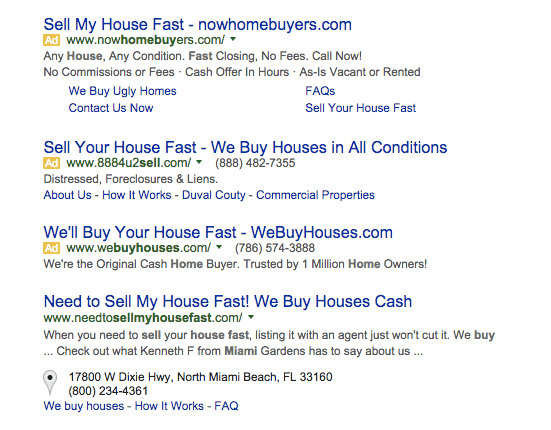
2. Use the Google Adwords Ad Extensions to grab more space on the page (they’re FREE).
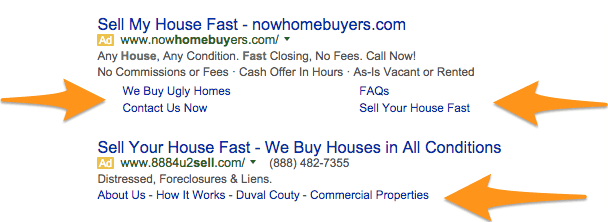
Google has this free thing they call “Ad Extensions”. This basically lets you ad little links below your main ad that link to other spots on your website. Like your “Fair Cash Offer” page or your “How It Works” page as an example.
Bit’s of content that your prospect would really value that will help them make their decision. These do help increase the number of clicks you’ll get… just make sure you’re sending them to pages on your website that are setup to convert them into a lead.
8. Have Clear Call To Action:
Let me ask you a question.
What’s the best way to make a sale?
Well… what I’ve found… the best way to make a sale is to clearly ask for the sale. That’s it.
Too many people try to dance around the subject and forget to clearly and confidently give their prospects a call to action that gets them closer to making a sale.
Take these ads below as an example.
Which one lays out how they can help me and gives me the most clear call to action of the 3?
Sure as heck not the 3rd one (the one outlined in Orange). That ad is too darn easy to just look past.
But the first one does a great job. It is very clear (even has a specific price point), lays out the benefits, and says they have an exclusive rent to own listing. Cool… I’ll check that one out!
TIP: Their call to action could be stronger by changing their “Sign Up Today” link to something like… “See Available RTO Homes” as our testing has shown works on our websites.
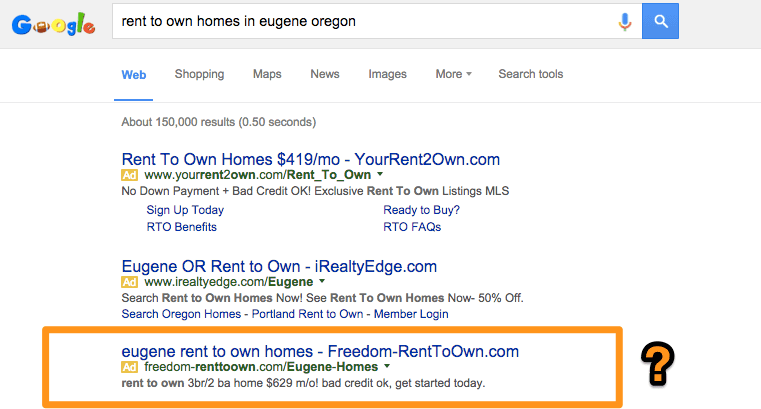
9. Create Effective Landing Pages:
All of the amazing high-quality motivated sellers or buyers from your PPC campaign won’t do you a lick of good without a landing page (or website) that performs well. You can see our conversion rate test blog posts we put out all of the time where we show our members’ websites pulling in sometimes 20%+ more leads just with tweaks we make to their websites.
This Carrot Client Has Driven Over 500 Rent To Own Leads Through PPC In Under 2 Months Because Of A High Converting Landing Page
So don’t waste your traffic sending it to a low-performing website. Start doing conversion tests today (or have us take that off your hands by joining Carrot on our Content Pro plan :-).
10. Use Geo-Targeting:
Geo-targeting your PPC marketing campaigns is a no brainer for real estate investors and agents mainly because real estate is such a geographically specific thing. If a person is looking for “rent to own homes in Ottowa canada“… odds are they’re in Ottowa or are of course at least looking for properties in Ottowa.
But not everyone uses the location in the actual search phrase. Some people may type “rent to own homes”… and Geo-Targeting is exactly how you get in front of those people in the areas you want to target.
This will help increase the click through rate (CTR) of your ads, increase the conversion rate on your landing page (if you send them to a city specific landing page), and help you cut down on wasted ad cost.
11. Test Different Ad Positions:
Most people think that the top ad in the Google search results is the best spot to be.
But this isn’t always the case.
Take a look at this graphic below.
Google PPC Click Through Rate By Ad Position
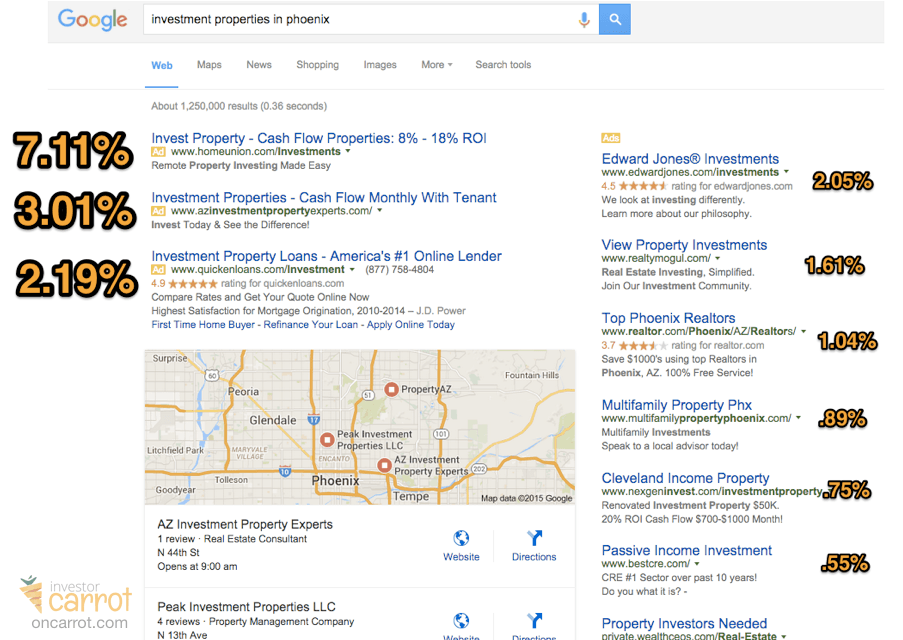
As you can see, the #1 ad does get the most clicks and it goes down from there, but that doesn’t tell the whole story.
Make sure to test what ad position is giving you the highest return on your investment… because it may cost you 3x+ to be in the first ad position versus the #4 position… but is the first ad position pulling you 3x the return on your investment as well?
Test things and see. If you aren’t patient enough to do this kind of optimization yourself… outsource your PPC. If you’re a Carrot member look in our Carrot Marketplace for our real estate investor specific PPC program that is crushing it for our members all across the country.
12. Test Different Ad Copy – Landing Page Combos:
Sometimes we find that one ad gets great clicks… but the landing page just doesn’t pull the opt ins as well as another. So make sure that once you find some ads that are pulling good clicks and they’re from highly targeted keywords that your prospect would type in… start to test other landing pages to see if you can mix and match to find the best performing combo.
13. Evaluate Quality Score:
Google Adwords has this thing they call the “Quality Score“. There are actually all kinds of quality scores that Google looks at.
All the way from an account wide Quality Score that Google uses behind the scenes… to Quality Score for your landing pages, ads, and so on.
The ones that are the easiest to control on your end is the Quality Score on your landing pages, ads, and campaigns.
On your landing pages Google looks for “relevant and original content, transparency, and navigability.”
In other words… look like a real company with real people behind it that care… and make your website easy for people to get the information they need from it.
Include things like a Terms of Service, Privacy Policy (which all Carrot sites have by default) and content that matches the promise that your ad lays out. Always try to improve your Quality Score… as we’ve found that the Quality Score is directly tied to improving your click costs in many cases.
14. Remove Ads With Low CTR:
One of the ways that Google adjusts which ad will show up where in the ad positions on a Google search is the CTR… or click through rate.
Ad Rank = CPC bid × Quality Score.
If the ad in position #2 is getting a CTR of 7% and bidding $2 per click… and the #1 position ad is getting a 4% CTR and bidding $2.50… Google may actually show the ad that is bidding only $2 per click in the #1 position because of it’s higher engagement with the searcher as indicated by the CTR (click through rate). Google makes more money this way because more people are clicking on the ad, the user wins because the ad is more compelling, and you win because you’re paying a lower cost for the same clicks because of well performing ads.
In fact, if you have ads or landing pages with a low quality score, Google may prevent them from even having a chance to show in the results at all. That’s how important optimizing for quality score is.
So make sure to go through your account on a consistent basis and remove your ads that aren’t performing well… and launch new ads to try to improve your CTR each and every month. This will help you continually improve your click cost and hopefully result in more leads at a lower cost.
Most leads at a lower cost is a good thing 
15. Remove Non-Performing Landing Pages:
Same thing as above… stuff that isn’t performing well… give it the ol’ “heave ho!”.
Remove landing pages that aren’t performing as well as your clear “winner” and launch new pages on a continual basis or launch split tests of your current page to always drive the conversion rate up.
Landing pages and ads that aren’t performing well can drain your bank account and inflate your ad cost in a big way… so don’t overlook these optimization steps if you’re doing your own PPC marketing.
16. Remove Keywords With Bad Quality Score:
Not to pile on the Quality Score bandwagon we started a few “tips” ago… well, actually yes… let’s pile on.
Quality Score is critically important to the health of your Google Adwords marketing campaign as a real estate investor or real estate agent.
So make sure that any keywords with a bad Quality Score are removed so they don’t pull down the overall QS of your ad groups and campaigns.
17. Increase Budget For Top Performing Keywords:
Once you’ve had a chance to make sure your Quality Score is solid and you’ve removed your non-performing keywords and landing pages… find the ads and keywords that are performing well (performance should be decided upon ONLY by the conversion of quality leads on your website or phone calls from those visitors… NOT by clicks), increase the budget on the keywords that are performing well.
As you can see in this screenshot from one of my Google Adwords accounts… after a little while optimizing this campaign… we found some winners then promptly increased our bids to get more clicks and convert more leads.
What Happens When You Focus Your PPC Dollars On The Ads And Landing Pages That Are Converting Leads
This client went from struggling to get leads in his market to closing several deals from this campaign alone within the first $1,500 in ad spend. But it didn’t happen immediately… in fact it took a few months to hone things in. But it was well worth it for the client.
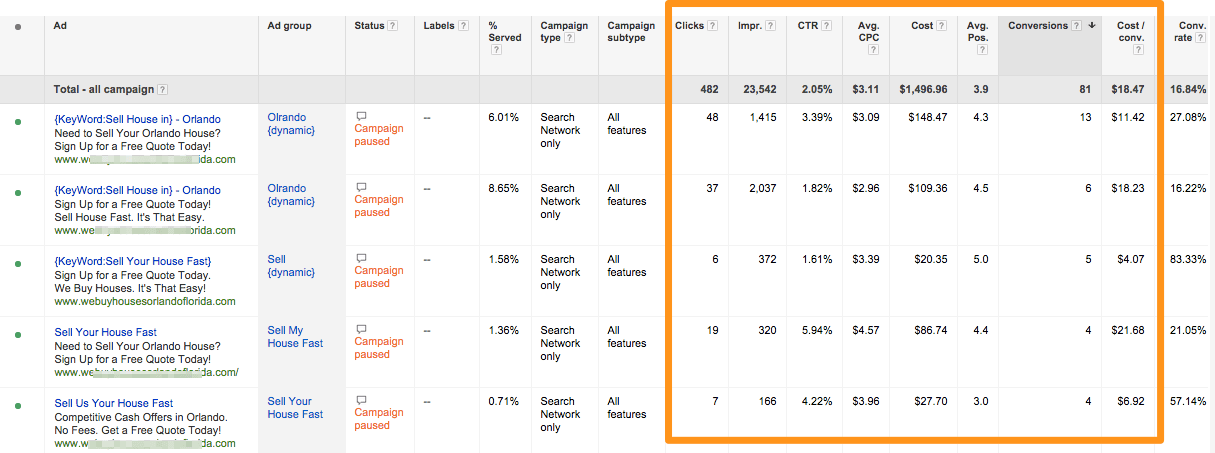
Some people may be thinking… “Well, what should I bump my max daily budget up to and my click bid up to?”
Really, as much as you can pay to still bring the results you want to bring.
One of the quickest ways to increase your lead flow on a campaign that is already pulling some leads is to increase your daily ad spend. Then if you’ve maxed out the amount of clicks you can get on that daily ad spend with that bid price… bump those bids up and test to see if the results still hold strong with a higher per click bid price.
This is why it’s important to never “set it and forget it” with your Google Adwords campaigns while you’re in the optimization phase.
18. Identify Non-Perming Keywords and Pause Them:
Then work through the campaign and find the keywords that aren’t performing well and pause them.
A Small Percentage Of Your Keywords Make Up The Most Ad Waste
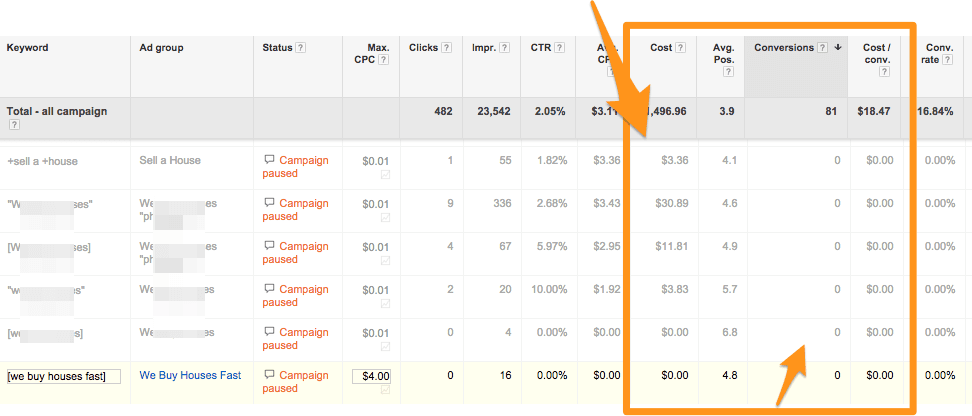
Really, since real estate is such a high profit margin product… 1 closed deal can flip an entire Google PPC campaign around to be from in the hole $1,500 to a $10k profit. So don’t quit too early or count certain keywords out too early.
But if you keep seeing a bunch of money being dumped into a keyword and it’s not converting into leads like it should… put a pause to those once you’re confident they’re not going to be good keywords for your campaign to focus on.
This is the #1 way that most do it yourselfers that we see doing their own PPC marketing can save a lot of money and headache… and sometimes cut their ad cost in half… is simply by getting rid of the keywords that just aren’t performing.
19. Optimize Your Bid Management Strategies:
As SearchEngineLand says, there are really 4 main goals that advertisers may have with their bid management strategy:
- Increase branding by driving lots of impressions while staying under a target CPM.
- Increase site traffic by driving lots of clicks while staying under a target CPC.
- Increase leads by driving conversions while staying below a maximum CPA.
- Increase sales by driving conversions with a positive ROI.
That’s a lot of acronyms eh?
Just as a refresher, “CPM” = Cost Per Thousand Impressions, “CPC” = Cost Per Click, “CPA” = Cost Per Action (i.e. – generating a lead), and “ROI” = Return On Investment.
For real estate investors we usually like to focus on staying below a maximum CPA… or in our world… staying below a maximum cost per lead.
This goes all of the way back to the start of this guide where we told you to determine your goal.
Once you do, that’ll help you determine your bid management strategy.
If your goal is to get as many quality leads as you can for below $75 per motivated seller lead… excellent! You’ll want to move your per click bid price around and your daily budget (assuming you have a high Quality Score on your ads, pages, etc.) until you hit that goal.
This post isn’t about the Google Adwords bidding management strategies that’ll help you save time, save money, and drive the leads you need at the cost you need… so look out for more on that in the future.
Or, do what you do best… and outsource your PPC to us in our Carrot Marketplace.
20. Optimize Your Campaign For Conversions NOT Clicks:
Easily 8 out of 10 real estate investors and agents I talk to who are doing their own Google PPC go silent when we’re on the phone and I ask them if they have conversion tracking on the campaign.
Conversion tracking is a simple thing you enable on your Adwords campaigns by getting a little piece of code from your Adwords account (here’s how) and putting it on your “conversion page”. Your conversion page is the page your visitors will see after they opt into your form.
For example, on InvestorCarrot, we have our streamlined “2 Step Lead Qualification Process“… so we make it easy for our users to put the conversion code on those “Step 2″ pages. It takes about 15 seconds in InvestorCarrot.
Even with our built in LeadSource Tracking feature (where our system will tell you if your leads came from Google SEO, Google PPC, Facebook, etc… so you know what marketing is working) you can’t tell which keywords and specific ads inside your Adwords account produced those leads without setting up conversion tracking in your Adwords account.
Why Conversion Tracking Is So Important. You Can See What’s Converting Leads
![]()
Many investors will just say “I’m getting leads, so it must be working”.
But what if you knew exactly which keywords and ads were the ones pulling the leads and which ones were the ones just costing you money? You could possibly drastically reduce your cost per lead just by turning off the keywords just costing you money but converting no leads.
Ready To Get To Work And Drive Those Leads With Google PPC!?
Google Adwords PPC marketing can be one of the most effective and fast ways to get your website in front of motivated sellers, cash buyers, tenants, rent to own tenants… and anyone else you’re wanting to reach.
But, it can take work, time, and experience to really crush it with Google PPC marketing.
As the great Google Adwords expert Perry Marshall says…
“Make sure you know what you’re doing before you begin, or you’ll lose your ass. “
The real estate investors and agents you see doing consistently well with PPC marketing aren’t just throwing ads up there and hoping for the best. They’re not even just throwing ads up there and checking it here and there.
They follow these steps above (or as many of them as they can) to really hone their PPC marketing campaigns to drive the most high-quality leads at the lowest cost per lead possible.
To put this all into perspective for you… the average wholesale deal right now nets $10,000 in assignment fees and the average flip profit currently nets $70,697 according to RealtyTrac… so if you’re going to give this a “try” with a few hundred bucks or even $1,000, save your money and don’t start.
Be ready to spend some time learning the Google Adwords platform…
… spending some good time in there optimizing things for the first several months, and be ready to invest at least $1,500 as a minimum before you decide if PPC marketing worked for you or not.
Recently a member who is doing very well with PPC for motivated sellers using our website system said that he didn’t close a deal until he’d already spent $1,500 in ads. Then he closed a deal that netted him $18,000. So if he would have quit after he’d had a month or two under his belt and $1,000 in ads spent… he would have missed out on that $18,000 profit deal.
So dive in, get to optimizing, and let us know how things goes!
5 Craigslist Marketing Strategies To Generate More Cash Buyer Leads Than You Know What To Do With 2 Sep 2015 10:31 AM (9 years ago)
What would you do if you found yourself with more cash buyer leads than you knew what to do with?
… I hope your answer would be that you’ll do more real estate deals!
For turn key real estate investors, wholesalers, and even house flippers…
… Cash Buyer Leads Are where Your Money Is
Whenever you need more money, go to your buyers list to curate demand!
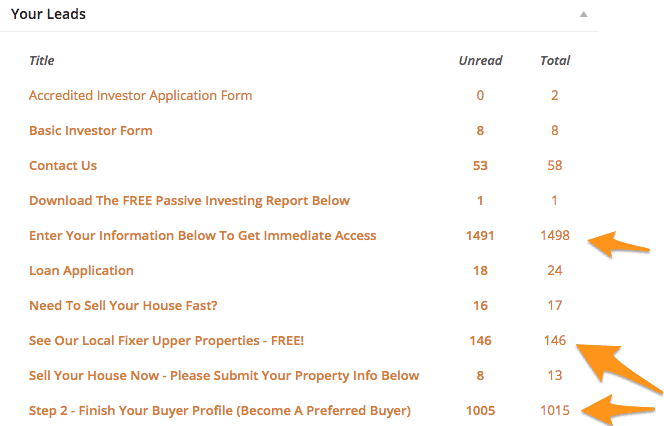
Like the screenshot above from one of our member’s accounts for just 1 of his websites in a market on the East coast… he has well over 1,000 cash buyers (1,015 of which took the next step and further qualified themselves. Those are solid buyer leads.
One perpetually attractive source of buyer leads is Craigslist.
Are You Leveraging Craigslist To Build Your Active Cash Buyers List?
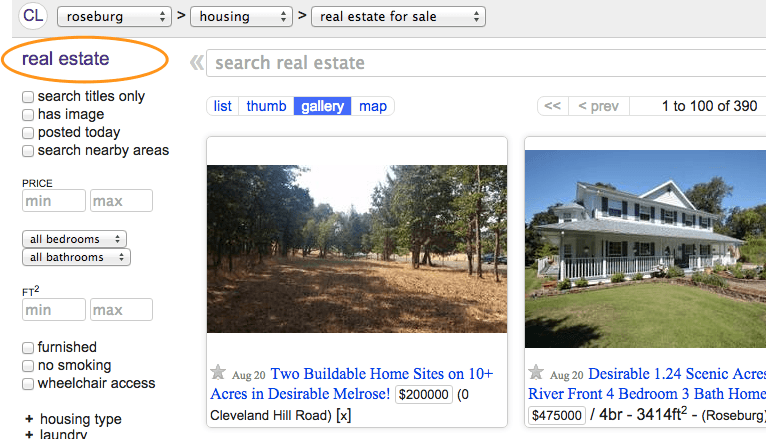
If you’re a real estate investor, Craigslist should be one of the sites you bookmark and visit daily to help you grow your business.
Craigslist has long been a treasure trove of leads for real estate investors, from buyer leads to seller leads to rental tenants to contractors, and more.
It’s so good because there are always many people on Craigslist at any given time and you can be sure that the people who are visiting the real estate section have some interest in real estate… that is, they’re at least thinking about participating in some kind of transaction (even if they’re not ready today).
Unfortunately there’s a dark side to that reality: there are a lot of people just like you – including agents and investors – who are hitting up Craigslist to find leads.
If you go to the real estate for sale section of Craigslist, you’ll be inundated with a list of properties, each title proclaiming in all caps:
“123 MAIN STREET!!! FIXER-UPPER”
“3 BEDROOM 2 BATH”
“COUNTRY CHARM!!!”
… There are a lot of all-caps and a lot of exclamation points. It’s easy to get lost in the crowd.
So, how do you master Craigslist to make it a key part of your buyer-lead-building strategy? And, how do you stand out from the crowd and attract more buyer leads?
Here Are 5 Strategies To Get More Craigslist Buyer Leads
Leverage these 5 Craigslist marketing strategies for your real estate investing business or even as a real estate agent.
Craigslist Marketing Buyer Leads Strategy #1. Put On YOUR Buyer Brain

Before you start posting your deals, you need to know who you are posting them for. So many properties in Craigslist miss out on a huge opportunity by creating mundane post titles like “3 bedroom, 2 bathroom!”
Is that the best information for your buyer?
Start by identifying who your buyer is. Do you sell to retail buyers? Rent-to-own tenants? Landlords? Flippers? Get as specific as possible. Maybe you are a turnkey wholesaler and your perfect buyer is an out-of-state owner. Maybe you flip properties and your perfect buyer is a rent-to-own tenant with bad credit but a good job.
Once you identify your buyer, you need to get into their brain and think about WHY they want to buy a property from you. No one cares about the address of your property until they are ready to visit. And not all buyers care about the number of bedrooms and bathrooms either.
Here are 3 simple but powerful tips to help get in the brain of your cash buyers with your Craigslist ads.
- Your out-of-state investing buyers want to know the cash flow numbers
- Your flipping buyers want an assessment of how much work is required to flip the property
- Your rent-to-own tenant-buyers want to know that you’ll work with them on their unique financing situation
You need to figure out why your buyers are looking in the first place… then build that information into your ads.
Craigslist Marketing Buyer Strategy #2. Create a Compelling Post Title That Speaks To Your Buyer’s “Why”
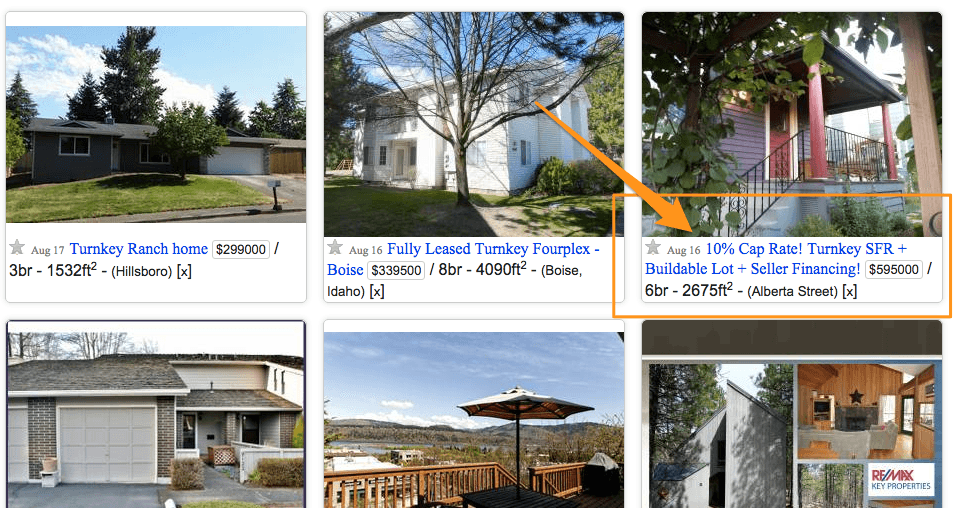
Your buyers have a reason for buying properties and it has NOTHING to do with the property’s address (that most people post as the post title).
Create a title that speaks to your buyer’s key reason for buying.
To borrow from the examples above:
Your out-of-state investing buyers want to know the cash flow numbers so a post title that catches their attention…
Turnkey property cash flowing $500/month”
Your flipping buyers want an assessment of how much work is required to flip the property so a post title that catches their attention… …
“Easy-to-fix property 50% below market, requires only $10K for a fast flip”
Your rent-to-own customers want to know that you’ll work with them on their unique financing situation so a post title that says…
“Bad credit? No problem with this beautiful rent-to-own home”
Should you include exclamation points and ALL-CAPS?
Those might have worked when people were first posting but it seems like most people are using that strategy now so you might consider using regular sentence case to write your title since it will be unique against a list of ALL CAP POSTS.
You should test both a regular (sentence case) title and an ALL CAPS title and see what works in your market… but in general I’m not a fan of all caps titles on Craigslist ads or email subject lines. It just feels like I’m being yelled at in a weird silent way 
In the end, it’s not important whether you use CAPS, symbols in your ad title, arrows… whatever. The important thing is that your ad title stands out visually in the list of other ads.
Which Craigslist Real Estate Ads Stand Out To You Below?
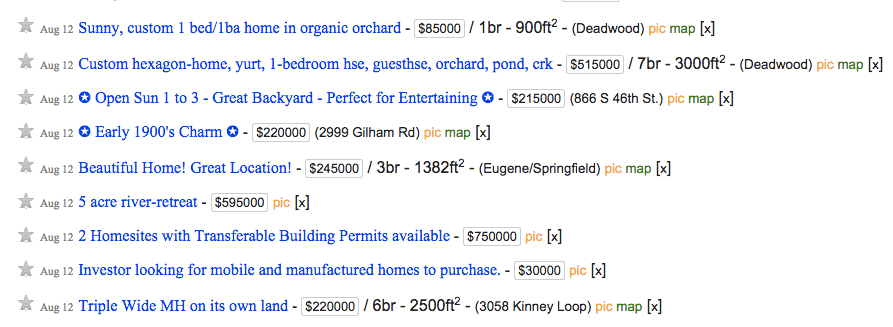
Making your Craigslist ads stand out… Notice how small changes in your ad title can make it stand out from the other ads. You can use symbols, numbers, or even just making your ad title a different length than the other ads on the page can improve the results of your ads!
Craigslist Buyer Leads Strategy #3. Attach The Best Pictures For Your Prospects Goal
Pictures are a challenging part of the real estate investor’s Craigslist marketing strategy. The burning question is: Do pictures help?
Here’s our assessment:
- If your buyer is a homeowner/retail buyer (that is: if they will be living in the property themselves) then pictures will help.
- If your buyer is an investor (i.e. a flipper or they want to own rental property) then pictures probably won’t help as much as the numbers. (They might help but not to the same degree as someone who will live in the property).
Also, the quality of the picture should really vary based on the type of buyer you’re looking for.
- Retail Buyers want to see very pretty and polished pictures. So post great pictures to catch their attention. When most retail buyers see a crummy picture that makes the house look bad, they immediately start thinking of all of the work they’ll have to do to make the house “pretty”.
- Turnkey Investors want to see pictures that show the house is nice, is well kept, in a neighborhood that’ll attract the type of tenant they want, etc. So you don’t need the ultra polished pictures like you may post for a retail buyer, but make sure the house looks like it’s in great shape and well kept in the pictures to turnkey investors.
- Cash Buyers / Flippers often want to see a house that is in rough shape in comparison to the others in the neighborhood. So don’t fret over trying to make your pictures fancy. In fact, fancy professional pictures could give the flipper / rehabber / cash buyer the impression that the house is too expensive and isn’t a deal. Show the flaws in the house, show what they’ll have to fix, but make sure to show the good parts of the deal as well.
Which Pictures Stand Out And Which Ones Don’t?
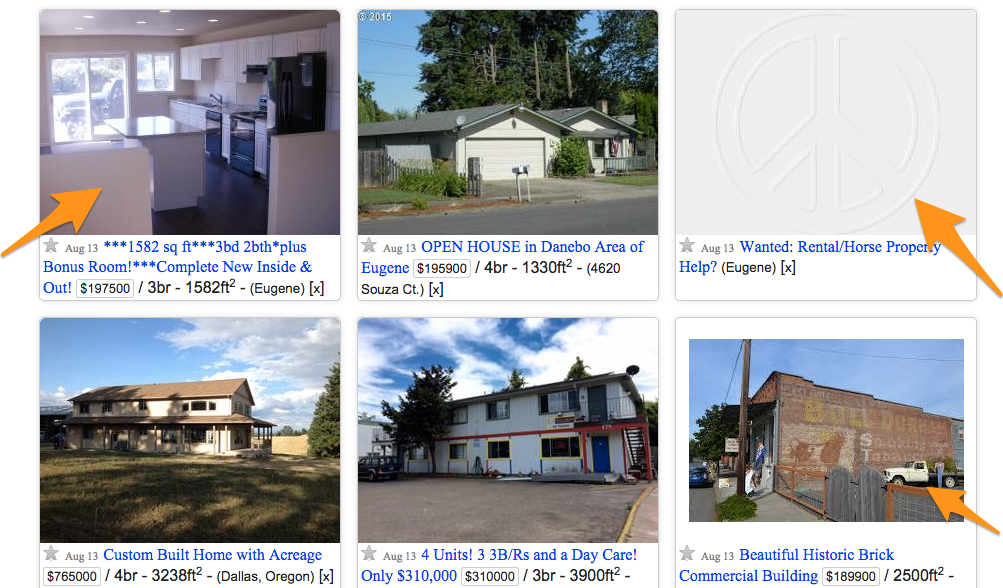
Craigslist has a “gallery” view now… that in many markets is the default view for looking at real estate. So are your ads standing out and helping grab your potential prospect? The pictures with orange arrows above don’t really show the property well and don’t grab your attention.
So again it comes back to knowing who your buyers are.
Many real estate posts have pictures in them and they aren’t great quality pictures.
One picture may show a room with windows; another picture may show a house with a tree in front of it. Clearly all of the pictures were taken on a smartphone. If you are going to take pictures, take great pictures (vivid pictures with plenty of contrast) that show key parts of the property that will interest your buyer based on their “why”.
(Flippers should see the parts that are great and the parts that need fixing. Cash flow investors should see that a property is solid enough to attract and retain good tenants).
But here’s one more argument against images: Since many listings do have pictures, your listing might actually stand out if you don’t have pictures – especially when Craigslist is in the thumbnail or gallery mode. So you can use the lack of pictures to your advantage if you have a great ad title that draws the real estate buyer in.
The main thing you want to do is stand out in the sea of other Craigslist ads.
Try both ads with images and without.
And try ads with great images and ugly ones and see which produces the best result for you following our guidelines above.
Craigslist Buyer Leads Strategy #4. Deploy A Pricing Strategy That Makes Sense

Price your property right… Sometimes playing the “$1” pricing game or showing no price at all can backfire and prevent your property from showing up to the right buyers. Price your property right. Also, recognize that the
As you post your listing, you are prompted to enter a price.
Here are the four possible pricing options you have:
- The right price
- A price that is too low
- A price that is too high
- No price at all
Although people can sort with high prices first or low prices first, potential buyers will rarely search for high prices first (because serious buyers usually want to pay less).
And if they search by price at all, your no-price listing may not show up at all.
This reduces your choices to: the right price or a price that is eye-catchingly low.
If a price is too low ($1.00) you might show up at the top of the list when sorted by low price first but what will you gain? You may incur the wrath of someone who wants to flag you for mispricing your property. Ultimately it will depend on the kind of deals you do and who your buyers are.
The best rule of thumb is to always price the property for your best price upfront.
Studies have shown that starting high then lowering over time actually leads to a 13% decrease in the sales price of the house.
Craigslist Buyer Leads Strategy #5: Include A Call To Action
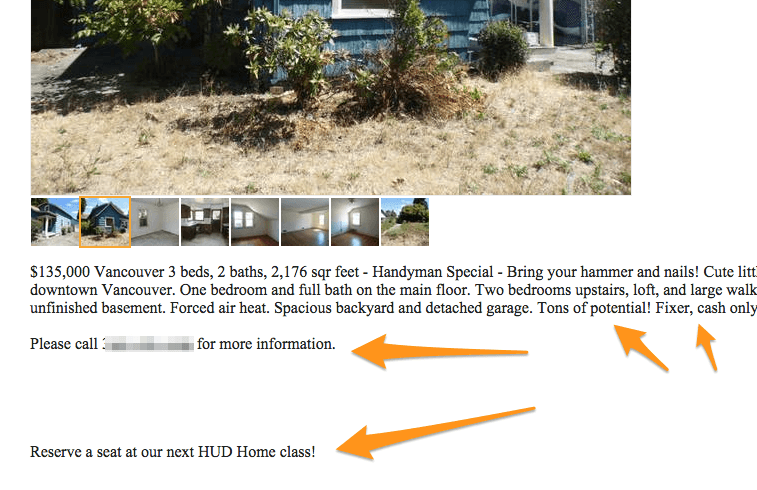
In the body of your listing, include relevant details that the buyer will find helpful. But most people stop there.
“2BR, nice community.”
While that might be true, people need to be told what to do next.
So create a clear call to action that entices them and reminds them of the urgency of the offer.
“Contact us today – this deal will go fast.”
You might also consider offering a bonus to leads who contact you. Make sure that the bonus is valuable, tied to your offer, and benefits your specific buyer (as identified in strategy #1).
Don’t get too aggressive on your free bonuses because they could cause people to flag your listing but if you take an authentic, measured approach that is targeted to a specific audience, you should find it helpful.
An example might be for flippers: “Contact me about this property and I’ll even throw in a $250 coupon for Home Depot upon closing” Or this one for out-of-state investors: “Contact me about this property and we’ll even waive our first months property management fee!”
Start Getting More Craigslist Buyer Leads Right Now
We have dramatically increased our business by using Craigslist in our real estate business” – Gary White
Craigslist is a powerful source of leads no matter what you use it for. If you want buyers, follow these 5 simple strategies to take your buyer lead building to the next level!
Want Fast SEO Results As A Real Estate Investor? Rush It, Ruin It 18 Aug 2015 9:26 AM (9 years ago)
There’s no denying that we live in a society that thrives on immediate gratification. Whether it’s personal or work, we want quick results, no time to wait.
So it’s not surprising when many real estate investors attach this “rush” approach to their SEO plan – it’s a disaster waiting to happen. There’s a huge difference between rushed SEO and strategic SEO that’s also aggressive.
The rushed approach flat out doesn’t work over the long run. Good SEO can be aggressive while also being strategic… now that’s effective!
The tendency to rush any sort of business investment is completely understandable, given the monetary expense involved. But when it concerns Search Engine Optimization (SEO), it’s time to replace the “want it now” approach with a “wait for it” mindset.
The chart below outlines some of the differences between bad SEO vs. good SEO.
Good SEO vs. Bad SEO
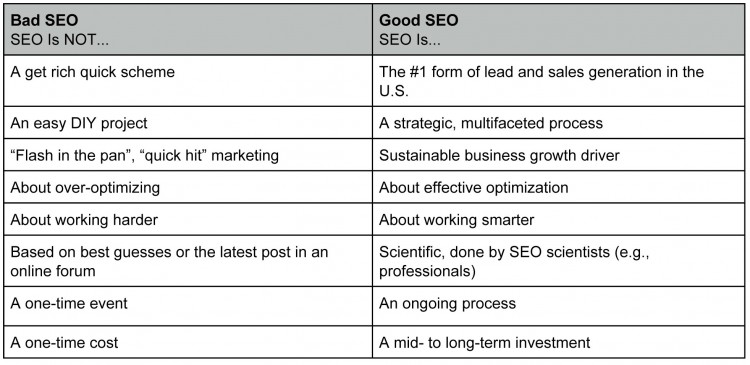
Faster Is Not Always Better… As you see in this chart, there are stark differences between rushed SEO and good SEO.
Organisms take time to grow, whether plants, animals, humans… and yes, even businesses. SEO is no different, it should be organic. After all, SEO is all about increasing a website’s organic rankings.
SEO is a strategic, well thought-out plan of action with the potential to give you a tremendous return on investment (ROI) for your real estate investment business, if given the chance.
How Rushed SEO Can Actually Hurt Your Website And Search Engine Results
It’s easy to jump the gun and over-optimize your website, which can prove quite costly when it’s all said and done. Mistakes are costly. Making a bunch of edits “just ‘cause” doesn’t work. Sure, there’s a chance you might get a “top 5” ranking right away. But, that’s only before Google flags you on your low quality links or spammy over-optimization and hits you with a major penalty.
Or, an unexpected Google update rolls out later down the road – that kills your rankings. In either scenario, you lose.
This actually happened to one of our clients in Denver
We had worked hard to get this business ranked in the “top 5” positions. But unfortunately, this customer had a tendency to rush things and did what they thought would help. Unknown to us, they purchased thousands of cheap, junk backlinks from Fiverr. Within days of the Google Penguin update, this client watched as his home buying website dropped out of the top 100 rankings.
The Google update I’m referring to specifically targeted “junk” backlinks. Just like that, their website was nowhere to be found.
Thankfully, this is the only one our clients that has ventured out on its own in an attempt to rush SEO.
The moral?
SEO Shortcuts Aren’t Worth It
None of us knows for sure when Google will make updates or what the nature of those updates will be.
So it just doesn’t pay to rush something (SEO) that’s “wired” for organic growth. When you rush your SEO, your rankings may pop up for a bit, but it’s all for naught when they drop (and they will) or disappear.
Engaging in “spammy” SEO techniques like PBNs (private blog networks for backlinks, link exchanages, using cheap overseas automated “link building” services) may bring immediate gratification, but they rarely lead to long-term results.
Don’t get me wrong, SEO should be aggressive, but it should also be strategic and “white hat”.
Let’s get away from the idea of 3-week results (or even 8 week results in competitive markets), and embrace the process of 3-month (and beyond) sustainable results.
I’m not saying that you can’t get great rankings in a month or two for many keyword phrases for buyers, sellers, or tenants.
You can and we do all of the time!
But those search phrases are usually “long-tail” phrases or less competitive search phrases in small markets.
With more competitive phrases, I guarantee your patience will be rewarded in the end.
Real World Results With SEO – From 0 Leads To Turning Consistent Leads And Deals With SEO
I’ve been doing SEO since 2003 and I’ve seen the fruit of SEO done “the right way” time and time again.
So here are 2 quick examples with real rankings graphs showing the timeline it took in these 2 competitive markets (for motivated house sellers) to go from ranking very low… to a #1 or #2 ranking and generating consistent leads each month and closing deals every month with SEO from those leads.
Example 1: Motivated Seller Leads w/ SEO In Baltimore
The picture below shows a snapshot of time while our client was implementing our SEO training. She went from ranked on page 3 to #1 for many top motivated seller search phrases in that market, and has held that ranking for nearly a year.

A Common SEO Rankings Graph… YES you can rank #1 in Google for almost any term you want to… with the right strategy and realistic timeline expectations.
The Analysis:
This investor in Baltimore, a highly competitive market, started her SEO in late 2013. The first few months she was really setting the foundation… then you can see her rankings climbed in the summer of 2014, bumped up, back down… then bumped up again and have stayed there ever since.
She now generates on average 20-30 seller leads per month, she doesn’t have to share those leads with other investors, and netted over $90k in profits in 2014 alone. Her 2015 is shaping up to be an even better year.
The Takeaway:
This client said in a case study we did with her that she felt like quitting 3-5 months in because it seemed like things weren’t happening fast enough. We encouraged her to stick with it… and boy is she glad she did! Now SEO is her #1 lead source and has produced well into the 6 figures in profits for her real estate investing business that never would have been there.
That’s SEO done right… not rushed.
Example 2: Motivated Seller Leads w/ SEO In Houston
The picture below shows a snapshot of time while we were doing the SEO (search engine optimization) for this client in one of the most competitive markets in the country for motivated house sellers.

Sometimes SEO Done Right Is Discouraging… because many investors want immediate results. Time and time again we see the scenario in this chart unfold in competitive markets. The website will sit in one spot for several months, seemingly not improving at all… then all of the sudden a big jump happens. We call it the “SEO sprout”.
The Analysis:
This investor in Houston, one of the top 5 most competitive markets in the U.S. for motivated sellers online according to our research, was able to climb from his page 2 ranking for several highly competitive motivated seller search phrases… to #1 for one of them and top 5 for others within 12 months.
This graph shows only a snapshot of time during our SEO campaign… but you can see the dramatic increase on the chart.
That increase happened about 5 months into the SEO campaign. During that 5 months the website bounced around the search rankings but generally stayed at the top of page 2 and bottom of page 1.
But then with aggressive but strategic SEO strategies Google updated their rankings and rewarded this website. Then you can see from July 2014 to September there was a steady climb up to the top of the search rankings… which also included (and still does at the time of this writing) a #1 position for one of the most sought after motivated seller keywords in Houston.
The Takeaway:
It took 8-10 months of strategic SEO to get the website into the top position in a crazy competitive market. Now that client is generating leads daily and closing multiple deals a month from his online marketing.
Our SEO service in competitive markets isn’t cheap, but the ROI this client is seeing is one of the best return on investments he has in his business today.
Shift Your SEO Thinking From Short-Term To Long-Term
We can show you hundreds of examples like those above now that our members control more page 1 rankings for search phrases that matter to real estate investors than any other website platform for investors… but you get the idea.
Growing a business is a long term proposition. Organisms don’t grow overnight. SEO is no different. And those who understand this will reap the rewards year after year.
By taking the time to create an organic and aggressive SEO strategy, you will be setting yourself up for success. Remember that you’re in business for the long haul, so make it count. If you are patient and resist the urge to rush it, then you will hedge against ruining it.
Still have questions about any aspect of SEO? Comment below.
Want Better SEO Results And More Real Estate Leads with Inbound Marketing?
If you’re not yet a member of our sister company Investor Carrot and want to know how we can help you get better results online… take our demo or reach out to us anytime. We’d be happy to hop on a strategy call with you to see if it’s a fit… or just head over and grab the plan that fits your goals the best. Most high achieving investors choose the Content Pro plan. They are the best real estate investor websites on the market! Also, don’t forget to check out Carrot’s Facebook page as well!
Referral Spam From Russia Showing Up In Google Analytics (Don’t Worry, Here’s Why) 12 Aug 2015 11:01 AM (9 years ago)
Today’s post is probably the most “techie” post we’ve ever had… and may be the most techie we have on here for a long while.
While we normally focus on how to help you generate online leads more effectively using inbound marketing as a real estate investor, we’ve been getting questions about today’s topic on a regular basis… so we thought we’d address it for those of you who are seeing this in your Google Analytics data and show you how to fix it.
So I want to warn you, if you’re not techie and don’t like to geek out on super technical stuff… this post may not be for you. But we’ll have an amazing post next week planned that’ll help you increase the amount of leads you’re bringing in from Craigslist. So keep an eye out 
Let’s dive in…
Recently we received a few emails from customer noticing weird sites from Russia showing up in their Google Analytics Data.
One of our members recently asked:
Playing with google analytics and have a lot of visitors from Russia hitting my website. Should I be worried?
And another asked us:
I noticed in my analytics that I’ve had 400 visits to my website this month but I’m not seeing many leads. Should I be concerned? I’m confused because I’m not really doing much to generate traffic and don’t know where those 400 visits could have came from.
These are both valid questions and ones we think need to be answered. So here we go, let’s understand what referral spam is and why you shouldn’t be worried.
First, What Is Referral Spam?
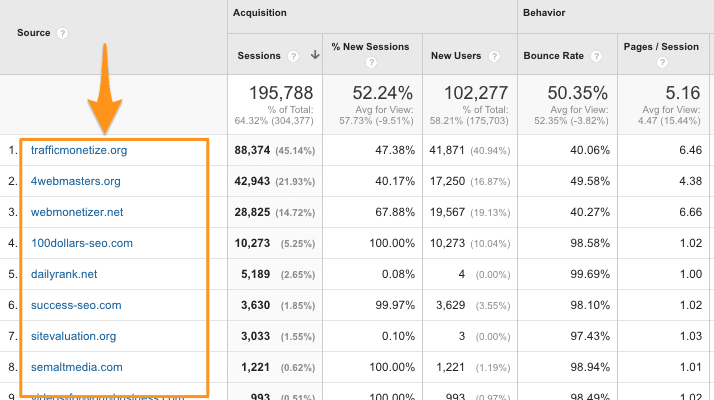
Referral spam clogging up our data for a short period… Since our members at our sister company Carrot are bringing in well over 130,000 visitors a month and 14,000+ opt in leads per month, even having 5,000 or 10,000 fake visits from a referral spammer can skew our data. But in this 30 day period in June, notice how many fake visits hit our servers. Over 195,000 fake visits in 30 days.
In simple terms, it’s when an automated website crawler visits tens of millions of websites per day for a split second… with the sole purpose of showing up on your Google Analytics “referral” list.
Now, these aren’t real visitors to your website… and now, spammers have gotten even smarter and are using different techniques that don’t even require them to visit your website to show up on your Google Analytics “referrer” report. They’re clever cats for sure.
Why do they do this?
Because they’re preying on our innate curiosity as humans.
If you were to log into your Google Analytics account and see several websites referring a lot of visitors to your website (like the shot above), you’re likely to be curious and go to those websites to see what they’re all about.
Most of these referral spammers offer search engine optimization services (that you’ll want to steer clear of for sure, as they usually use techniques that Google doesn’t like)… and they’re hoping that a fraction of a percent of the people who visit their site end up as a customer.
Take for example, SEMALT
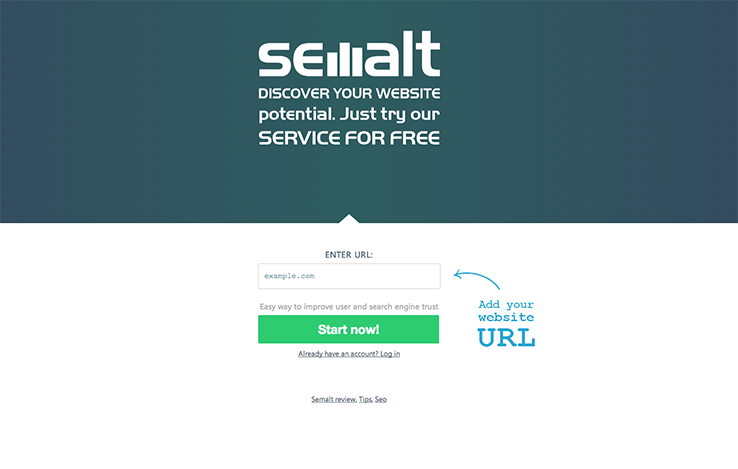
SEMalt is one of the biggest referral spammers… And when you go to their website they offer services to help “improve your search engine trust”. A very small percentage of people who saw SEMALT in their Google Analytics went to this site, put in their info… and bought.
This very “dark” marketing tactic that the referral spammers employ should be a good indication of the quality of their service. Stay away from the services they offer.
It must work, because these referral spammers keep on doing it.
How We Protect Our Customers (And You Can Protect Your Own Site Too…)
Now, there’s nothing that we’ve found that is dangerous to your website about referral spam.
There have been adware or virus’ attached to some of these websites in the past, so don’t visit those websites, but in general there’s no real hard evidence we’ve seen of any direct harm caused by referral spam traffic on your analytics.
It’s just annoying and really messes with the accuracy of your Google Analytics data.
Here Is The Most Recent Referral Spam Surge We Blocked

Notice the surge in “traffic” in the first 2 weeks of June… then after we blocked the spammers notice the sharp drop off. We’ll show you how to protect your own website and analytics from referral spammers.
This is a proactive process we take as soon as we see referral spam starting to hit members websites, we block it from the server so that same URL can’t affect your website anymore.
Another example, SEMALT…
… we noticed a referral site named Semalt was affecting some of our member’s Google Analytics accounts so we made an .htaccess rule (fancy speak for, “we took are of it”  that blocked them from visiting our server and our member’s websites.
that blocked them from visiting our server and our member’s websites.
Check out the screenshot below from our analytics from October 2014 – January 2015 when the SEMALT referral spammer was hitting a handful of members’ websites…. and notice the dramatic drop in the blue line after we put that in place.
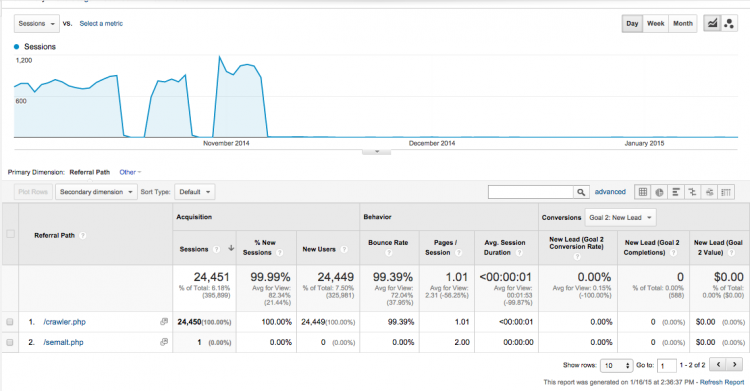
Results of removing Semalt traffic
Again, this has nothing to do with helping you generate more leads, but everything to do with helping you as a real estate investor make sense of your Google Analytics data if you’re seeing referral spam traffic land on your site.
Here’s an example of what it would look like in an htaccess file.
Again, these kinds of things should go over the head of 99% of real estate investors. Why? You don’t want to have to be worrying about this kind of stuff… have a solid web guy help you… or leverage systems that worry about this stuff for you.

But Semalt is just one type of referral spam coming from overseas (specifically Russia). The spammers are clever and persistent. When one of their websites stops becoming effective, they’ll spin up another website, start throwing spam “referrals” at millions of websites and capitalize on the small percentage of those website owners who’s curiosity gets the best of them.
Yes, it is annoying, but not much can be done other then reactively blocking the referral spam websites that show up in your analytics reports (which we handle for you).
Not All Referral Spam Is Created Equal
Now, for those of you who are pretty geeky and like this kind of stuff… there is some type of referral spam that is currently almost impossible to squash.
Some Russian referral spammers have discovered that they can get the same result (their website showing up on peoples Google Analytics reports) without having to have their “bots” actually visiting the website.
How?
They discovered that they can “scrape” the Google Analytics tracking ID from the website… store the ID #… and just ping that ID number over and over again with their fancy spam “bots”.
This way, they can flood your analytics with their referral data, but the method to block them from your server like we showed above won’t work.
What can you do about these ones?
Right now, nothing. We’re all hoping that Google will take steps to prevent this on their end sometime soon. If they do, we’ll let you know.
So, Does This Referral Spam Traffic Hurt My Search Engine Rankings?
A lot of users are concerned that these visits are going to negatively affect their search rankings because of the high bounce rates and low “time on page” that the spam traffic leaves behind.
Notice The High Bounce Rates From Referral Spammers

High bounce rates, but it shouldn’t effect your search engine rankings… because these bounce rates are from “referred” visitors vs. visitors who came from a Google search.
After our research and talking with other SEO experts, there is likely no SEO effect because the spam bots are not coming through as organic search traffic (a Google search) but rather “referral traffic”. A high bounce rate can effect your rankings from what we’ve seen on visitors who land on your site from Google searches… but we haven’t seen data to show that high bounce rates from referred traffic has an impact.
So don’t worry about this affecting your search rankings. Kapishe?
How You Can Filter Out Referral Spam In Your Google Analytics Reports
You can add filters to your Google Analytics to not show the traffic from the referral spammers if you’re concerned about the accuracy of your reporting.
For the best guide on how to do this, head over here to Moz.org.
So What Do You Do Next?
If you have a website that you’re hosting yourself or have on another website platform and you’re seeing referral spam show up in your Google Analytics account… have your web guy block the websites with our .htaccess file tip above. And continually keep an eye out for new spammers that pop up and keep sending the URLs over to your web guy to have them block those websites on your hosting account.
In the end, referral spam isn’t something you as a real estate investor or agent should ever have to worry about or spend any time on. You should have someone on your team or align with a service to do all of that monitoring and blocking for you… so you can focus on what you love to do.
But with the increase of referral spammers out there, it is important to squash them in their tracks if you want our Google Analytics data to be accurate and useful.
I’m curious to see how many people reading this post are seeing referral spam on their analytics but had no clue what it was until today.
Let me know in the comments section below if you’ve found referral spam on your own Google Analytics account.
Where 13,298 Real Estate Investing Leads In 30 Days Came From (screenshots and all) 28 Jul 2015 2:39 PM (9 years ago)
“How do your members generate all of those leads?” – the question we are asked all the time over at our sister company Carrot.
It’s not an easy answer in one sentence, so we’re going to dive in on this blog post to walk through where the leads our members are pulling in are coming from to give you a better idea of how you can generate more leads yourself online as well.
Plus we’ll walk you through how you can tap into this source of leads as well… and grow your real estate investing business leveraging Inbound Online Marketing with InvestorCarrot as well.
But even better, we’re thinking about starting a monthly “lead generation stats” update here on this blog to show you where the leads are coming from, what marketing methods are bringing them in, what parts of the country they’re coming from, and more.
Let me know in the comments area at the bottom of this post if that’s something you think would be valuable. If we get enough comments about it we’ll start doing it every month!
Now A Few Quick Notes Before We Dive Into The Good Stuff
- What types of leads are they? The leads we are showing are motivated seller leads, cash buyers, rent to own tenants, note sellers, and some private lenders mixed in there. The cash buyer, rent to own tenants, and motivated sellers make up the bulk of the leads you’ll see.
- Do these leads include people who called on the phone? Nope, the numbers you’ll see on this page are ONLY leads where the seller, buyer, tenant, etc. put in their information into one of our InvestorCarrot members websites. Right now we can’t track phone call leads on members websites, but from our surveys and talking with customers, that is likely another 2,000-5,000+ leads per month coming in from phone calls. But for the sake of this post, we’re only going to show what we can back up by data… and since we can’t currently track phone calls our customers receive… we’ll leave those leads out for now.
- What are leads that show up as “Direct” in the stats? Great question! Google started showing a huge hunk of traffic in Google Analytics as “Direct (none)” a while back. In the past, “direct” meant that the person actually put your URL into the browser and went to your website. But now Google is mixing in a huge number of visitors that actually came from Google searches. Some studies show that 60%+ of the traffic that shows as “direct” is actually from Organic Google search. Google just does a good job of hiding that from us for some reason. So for the sake of this post, we’re going to say 60% of the “direct” lead source is actually SEO related.
Where Did The 13,298 Opt In Real Estate Leads Come From In The Past 30 Days?
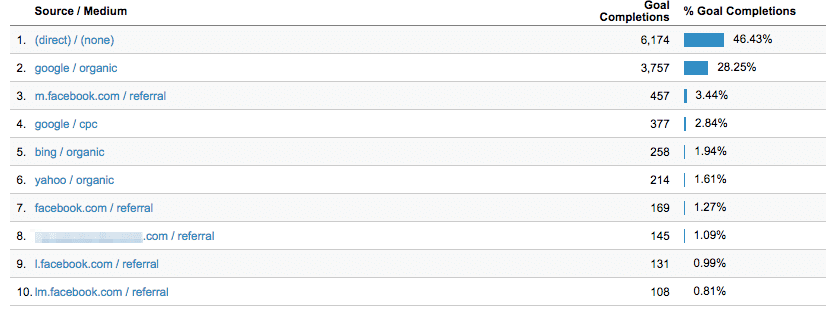
Real Estate Investing Lead Breakdown… this snapshot shows the breakdown of leads generated in the past 30 days through InvestorCarrot.
First off, you won’t find this kind of openness on actual data anywhere else in our industry. Transparency is one of our core values, so we’re going to open up our doors and show you all kinds of cool stuff  It makes it fun that way too!
It makes it fun that way too!
But as you can see, the vast majority of the leads in the past 30 days are from organic SEO… inbound marketing (especially when you add in 60% or so of the “(direct)” leads which are also likely form organic traffic in Google.
Google won’t give us the specifics on this data, but another hunk of the “(direct)” lead are likely from Craigslist ads. They show up in the “(direct)” section because Craigslist doesn’t allow live links in real estate ads any longer in the majority of cities… so people have to copy and paste the URL into the browser to go to the website… which would make it a “direct” link to the site.
And then you’ll see an array of organic traffic from other search engines, paid traffic from Google PPC and Facebook as well.
Below we’ll dive into the data a bit more on the top ways our members are generating leads so you can get a bit of a behind the scenes look at how real estate investors in in markets across the country are generating their leads.
Inbound Marketing / Organic SEO Real Estate Investing Leads

Yes, SEO works GREAT for real estate investing leads… As you see, Google accounts for 88% of the leads through SEO, followed by Bing and Yahoo. The far right column in the snapshot above are the lead #’s. The average conversion rate is 8.04%, which includes websites that Carrot members have not taken the time to add any branding or credibility elements to them (which help increase the conversion rate). See this blog post to see the average conversion rates by website type across our system to get a full conversion rate breakdown.
SEO and Inbound Marketing are again the #1 source of leads for our InvestorCarrot members in the past 30 days.
The reason?
We’ve focused a lot of time and energy into building out our platform and our training to help make ranking well in Google for search phrases that matter easier and more effective.
Our customers control more page 1 and top 3 rankings in Google for search terms that matter for motivated sellers, cash buyers and rent to own tenant buyer than any other single real estate investor website platform.
Which is something we’re proud as heck about!
We’ll continue to focus on innovating with our platform, SEO tools, and training to help members continue to leverage inbound online marketing and SEO to grow their real estate investing businesses.
PayPerClick Marketing Leads

PPC Marketing... wasn’t as big of a part of the overall lead generation pie as it has been in previous months, but it still pulled in over 500 leads in the past 30 days (the vast majority of them motivated seller leads)
PayPerClick is an amazing way to get motivated house seller leads coming in quickly (or any other type of lead as well).
The main reason I feel it only accounts for less than 5% of the leads in the past 30 days is because the perceived barrier of entry for the average real estate investor is higher.
In competitive markets like Houston click costs can reach upwards of $20+ per click (my most recent quick search shows a Google “suggested bid” on top keywords in Houston and Dallas north of $40 per click).

So PPC in really competitive markets isn’t for the faint of heart or for those who don’t have a solid budget to start with.
But we are seeing that those who are using PPC are seeing really solid results in conversion rates and turning leads into deals.
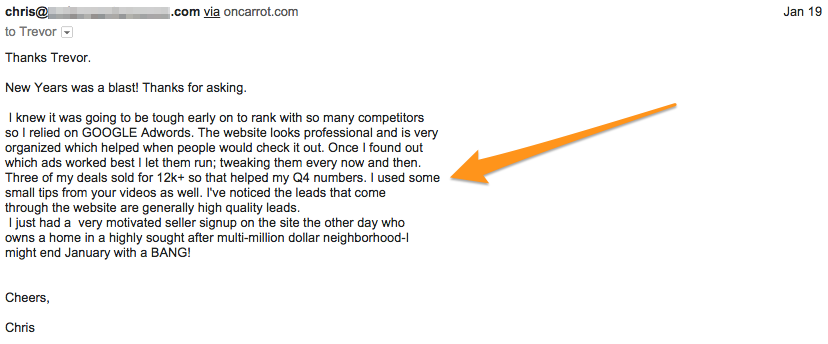
Member Chris C. from Cincinnatti told us on a Mastermind Call that he’d netted $50k in profits in the 4th Quarter of 2014. Then he sent this email to tell us how he did it with PPC.
Numerous others reached out to us this past month as well about their PPC success. So we’ll have a bigger focus on PPC moving forward in 2015 to scale that up as a lead source with our members. The average conversion rate on our websites over the past 6.5 months has been just north of 8.5% (average). You’ll see in the screenshot above the conversion rate is a bit shy of the average but with some updates we’ve made to the system in June we’re seeing that average conversion rate number on PPC go up just shy of 9% which we’re excited about!
Social Media Marketing Leads
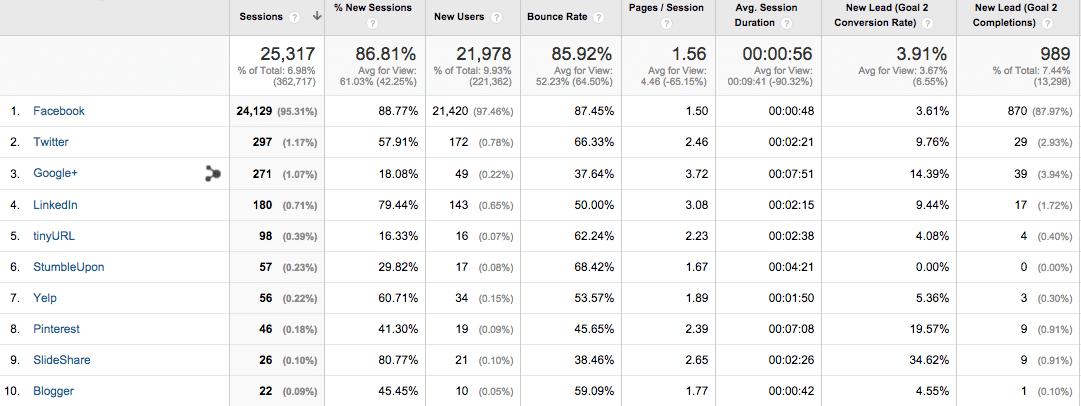
Social media lead generation breakdown… You can see that the majority of leads our members generated in the past 30 days from Social Media came from Facebook (Facebook ads mainly) and a much smaller % from Twitter, Google+, and LinkedIn
Social media marketing hasn’t been a huge focus for most of our members, but increasingly we’re able to leverage Facebook really effectively to generate cash buyer and rent to own tenant buyer leads.
In the snapshot above, you’ll see that Facebook has generated the most traffic and leads (the leads are the far right column) than any other social media platform by far. But some people are starting to leverage LinkedIn, Google+ and even sites like Slideshare and Yelp effectively to add onto their lead sources. We teach how to leverage Slideshare and sites like Yelp effectively as a part of the overall mix of online marketing in our 3 Lead Per Day Training course.
Craigslist Marketing Leads
Craigslist leads are almost impossible to track on our end because the majority of our members just put their website URL in the ad rather than a tracking URL. And since Craigslist doesn’t allow clickable links in ads in the real estate section for the most part any longer, the prospect has to copy and paste the URL into their web browser.
So these visitors and leads show up in the “(direct) / none” group of leads as well.
But we do know that Craigslist has been a really solid lead source for our members over the past year for rent to own tenant leads, cash buyers, and on a lesser degree motivated sellers.
We do find that the conversion rate on a Craigslist visitor is lower than SEO or PPC, but you’re able to pull a volume of leads out of Craigslist. You just need to make sure you have a system built into your website to automatically qualify your leads better so you don’t have to waste time on tire kickers.
What To Take Away From This Report – Inbound Marketing Works
The main thing I think you can take away from this blog post is that there are many ways to generate leads online as a real estate investor… and there is no single “right” or “wrong” way to do it.
Some people swear by PPC and don’t ever do any SEO because they have a marketing budget to spend on ads and would rather have leads coming in quickly.
Some people swear by SEO and barely touch PPC.
But the big thing here is that Inbound Marketing is a massively effective way to generate leads online as a real estate investor.
The vast majority of the 13,000+ leads in the past 30 days came from Inbound Marketing. From leveraging great content to rank a website for search phrases that motivated house sellers, cash buyers, note sellers, rent to own tenants, etc. are searching for every day.
Inbound Marketing does take more patience and a long-term focus, but as you can see… if you do it right and leverage tools like InvestorCarrot that help make things easier (and our support to help you when you’re stuck)… Inbound Marketing and SEO can be among the highest ROI marketing methods you can use as a real estate investor or agent.
So, decide on the best online marketing mix for your real estate investing business and get to work!
Want To Work With Us?
If you’re interested in leveraging our Inbound Online Marketing platform at InvestorCarrot, our training, and our support team, take a demo or checkout our plans.
Over the coming months we’re developing new PPC landing pages (we’re actually testing them on PPC campaigns right now), new SEO tools to help you more effectively rank in Google, and beefing up our Customer Success team to help investors… from beginners to the most advanced… leverage the web in a more effective way.
3 Simple YouTube Video Marketing Tips To Add “Layers Of Optimization” 22 Jul 2015 9:05 PM (9 years ago)
“Help! My YouTube videos are not ranking even though I am optimizing my title, description, and tags!”
Is that you?
Do you have some videos up on YouTube but they’re just not pulling any good rankings in Google and not getting you any extra leads?
If so, you’re not alone.
It’s a pretty darn common frustration people have after seeing other peoples videos ranking #1 for a keyword phrase for motivated sellers, buyers, or tenants… and they thought they did everything right and their video is stuck on page 3 (or nowhere at all).
I Had The Same Frustration When I First Got Started Doing YouTube Video Marketing In Real Estate
It was frustrating to know as I was following “all the steps” but just couldn’t get any of my videos to pop up onto page 1 in Google.
Soon after, I began to realize that it wasn’t that I was doing anything wrong – I just wasn’t doing enough to fully optimize my YouTube videos.
Especially if I was trying to rank for a very competitive keyword phrase in a highly competitive real estate market.
Phrases like “sell my house fast fresno”… phrases people are typing in every day to find a solution to their problem… but tons of other investors and real estate agents were also trying to get in front of them in Google with their own websites and videos.
In this article, I am going to give you some simple ways to add layers of optimization for your YouTube videos so you can increase your rankings in the YouTube and Google search engines….
… so you can add that extra online asset to help you grab more traffic, leads, and close more deals.
Once I learned the basics of YouTube video marketing and optimization… I’ve learned other more advanced ways to get my YouTube videos ranked higher in Google (and to generate more leads and deals in turn).
Note: Adding layers of optimization is assuming you have also optimized your videos with the Title, Description, and Tags which is the foundation of your video optimization.
Let’s get this party started!
YouTube Video Optimization Tip #1: Optimize The Filename Of Your Video File
One thing to understand when Google indexes YouTube videos, they don’t know what your video is about unless you give them that info. Google is only able to crawl content based on text. By understanding that, here are some ways to give them that text they can crawl.
First, name your video from its default file name to your targeted keyword and location. By doing so, you can help Google know what your video is about. As you see below in the image, after I completed my video from editing, the default name is “final.” (If you buy videos from Fiverr or anywhere else, pay attention to the default file name. Some are letters, some are numbers only or both.)
Default Video Filenames

Yep, Your Filename Matters… Renaming your video filename is a simple step, for both a PC and the MAC, just right-click using your mouse while you have the video file highlighted. You should see an option to rename your video file
Using the same video file as my example in the image below, you will see how I changed the video file name from the default filename my video camera gave to the video… to a filename that now includes my targeted keyword and market city.
Then I re-uploaded the video to YouTube to replace the “old” one with this new better optimized video file.
By naming your video file to include your keyword phrase and target location / city, you are able to let Google know what the video is about a little bit more than before.
New, Better Optimized Video Filenames
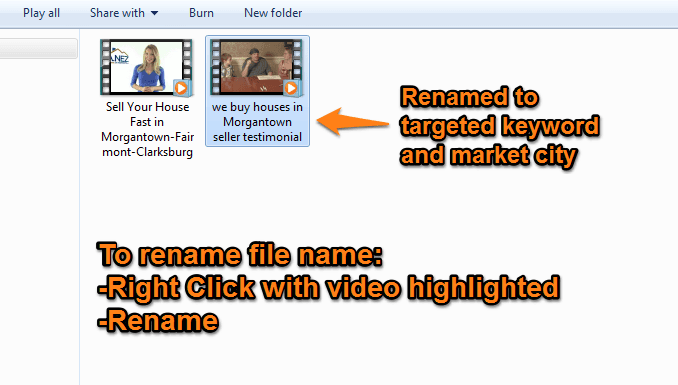
See The Difference? If you can now have a better idea of what the video is about without watching the video, so will Google. Helping Google know what your videos and pictures are about helps it have a better idea of what your video is about.
Pretty simple eh  Now you can upload the video!
Now you can upload the video!
Time To Complete: 2 Mins Per Video
YouTube Video Optimization Tip #2: Include Your Target Keyword Phrases In The Actual Words Spoken In The Video And Add Use The Closed Caption Settings
YouTube is pretty darn smart these days.
But it always helps to give YouTube and Google information so there’s no guessing what is in your video.
A really slick tip is to make sure that you use your keyword phrases in the actual words spoken in your videos and turn that into written text that you can submit to YouTube as the “Closed Caption” text for the video.
By doing this, you are doing 2 things that’ll make your videos more effective.
FIRST, Not directly related to SEO or ranking your video, you are laser-focusing your content on your targeted location and the benefit you can help the person watching your video with, which will help make your video more effective in getting the viewer to take that next action to work with you.
If you have apartments for rent in Santa Fe, use the words “apartments in Santa Fe New Mexico” in the voice over on your video (because that’s a popular phrase people are likely typing into Google who are looking for apartments in that area).
As another example, if you’re a house buyer, your video should communicate you are a “local” buyer. Just as your investor website should communicate you are a local buyer, your YouTube videos should do the same.
SECOND, When you add the text for the Closed Caption settings for your videos, you’re giving Google extra content to index and help rank your video.
Remember Google doesn’t watch your videos, so it only knows what the video is about based on what we tell it. By using the closed captions feature that YouTube offers and making sure your keyword phrases are spoken in your video som, it will help you rank your YouTube video better in Google.
Notice The Closed Caption Text Popping Up On This Video
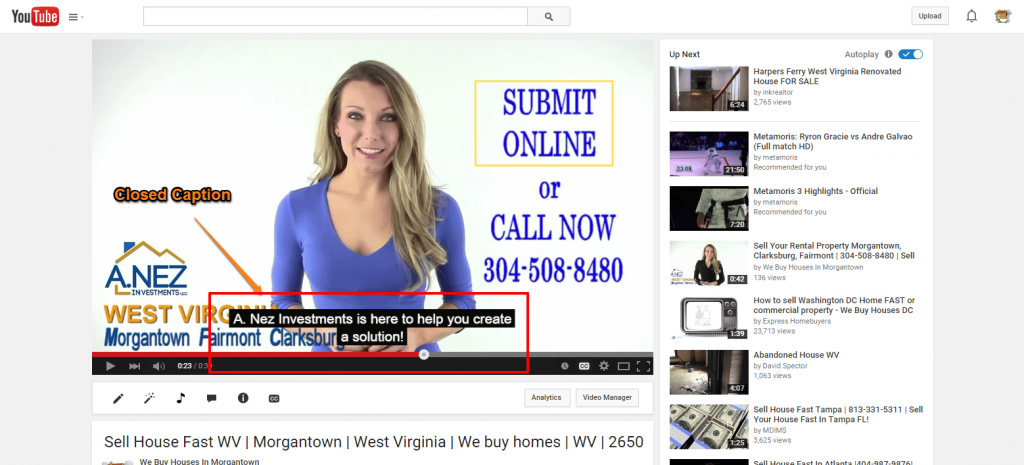
Time To Complete: 5 Mins Per Video
Youtube Video Optimization Tip #3: Add A Customized Thumbnail To Your YouTube Videos
Just as you changed the default video file, you will do the same thing with your custom thumbnail image.
But this time, use a secondary keyword phrase in the image file name.
Let’s say you made your video file about “we buy houses in Fresno”, a secondary keyword phrase a motivated house seller in Fresno may search for in Google may be, “sell my house fast in Fresno.” So make a variation of that the title of your thumbnail image.
Remember you always want to diversify your keywords. Never keyword stuff the same term in your overall YouTube optimization or your website… Google will “reward” you with dropping your rankings.
Step 1: Click “Custom Thumbnail” In The Video Settings Area
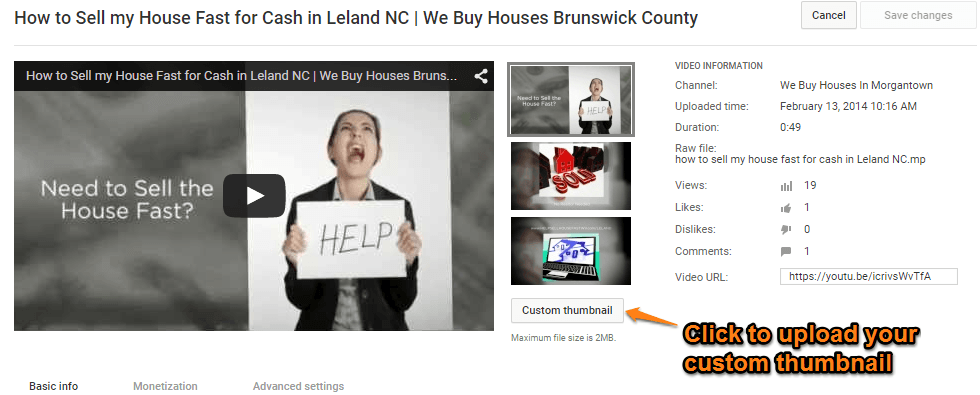
Step 2: Find Your Custom Thumbnail And Upload It
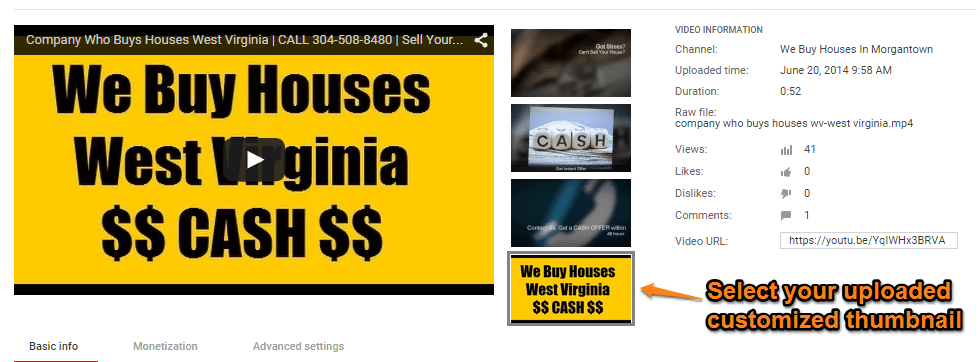
Step 3: See The Difference Online + Get The Potential SEO Boost In The Process!

A side benefit you’ll get if you take some time to make sure your custom thumbnail is a visual that is compelling and interesting, is it is almost like you are creating a little bandit sign that grabs peoples attention there in the Google search results… which increases the click through rate of the video and can help increase the ranking of the video as a result.
Time To Complete: 2 Mins Per Video
Implement These And Other Ways To Improve Your YouTube Video Rankings In Google To Capture More Rankings And Leads
Those 3 quick tips are just 3 of many ways to improve your YouTube video rankings in Google in competitive markets, assuming you’ve already optimized the basics correctly (video title, description, tags, etc.).
But other ways you can get your videos ranked higher in competitive markets include…
- Social interaction on the video pages – Get people to comment on your videos (so DON’T disable comments!), FB like, and G+. Google likes seeing interaction and uses that as a way to tell if it’s a quality piece of content or not.
- “Page Authority” – YouTube already has the highest domain authority possible (which is a good thing), so another way to increase your rankings is by improving the “page authority” of your YouTube video. The “social interaction” tip above can help with that, but so can back links that point to the video, age, and more!
- Have an active YouTube channel – YouTube will reward channels that are more active. If you have 1 or 2 videos on your channel and your haven’t even added a custom profile image on your YouTube channel, you may want to make your channel more active. Get more videos in there and customize the look and feel of your channel a bit.
Take these simple but powerful YouTube video optimization tip into action and watch your videos climb the rankings!
6 Simple Tips To Master Location-Based SEO And Skyrocket To The Top of Search Engine Results 15 Jul 2015 8:45 PM (9 years ago)

In the early days of the web (the “caveman days” when we were still rubbing two sticks together to make websites out of html) there was a land rush on high level domain names of one or two-words for really general phrases. Things like “realestate.com” and “homes.com” as an example.
At the time, targeting search terms like “real estate investing” was in high demand.
Today, people are a little more sensible (a little more) and they understand that owning a domain name with only one or two words might work if you’re trying to offer generic information to a wide audience but not if you’re trying to market to a specific location-based audience.
Targeting a search term like “real estate investing” makes sense for a wider, more generic audience, while targeting a location-based search term makes far more sense for most investors who are buying, renting, and selling properties.
Here’s What I Mean By A Location-Based Search Term
If you live in Chicago and you want to try a new restaurant, you wouldn’t likely sit down at your computer and just type “restaurant” into the search engine.
You know you may get a whole bunch of links… none of which will be relevant to you.
Instead, you type something like “Chicago restaurants” or perhaps even something more specific, such as “pizzeria” and the name of a neighborhood in Chicago.
And the restaurants that show up for that search result? They were smart enough to use location-based SEO to optimize their websites. They built their sites around the location-based keywords that you used to search.
Yes…
… Google is getting better and better at creating location based search results on the more generic topics where people are likely looking for something in the city they’re searching… like “restaurants”, “plumbers”, and “real estate agents”. But for the sake of what most real estate investors want to rank for, Google hasn’t quite figured out how to know the most relevant location to serve up results for terms like “investment properties”… so they show national results.
Location Based Results On A General Term I Searched…
(I’m in Roseburg Oregon)
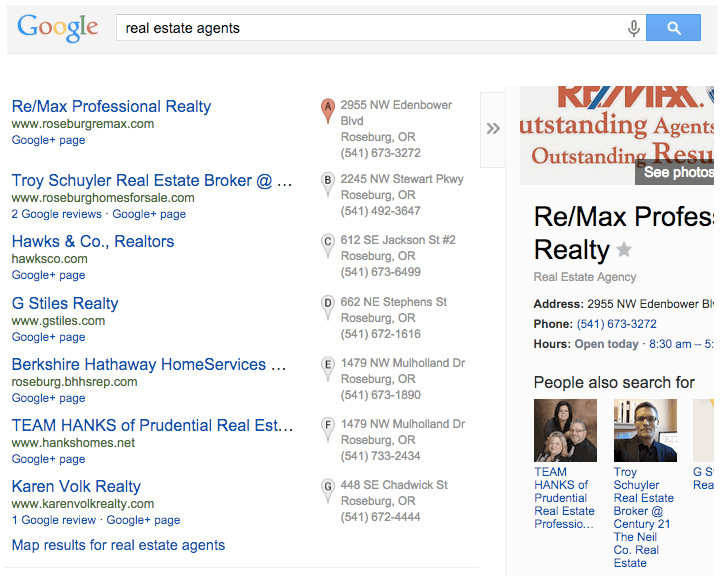
Google Serving Up Location Based Results… on the more generic topic that tend to be very local in nature. Like agents, restaurants, plumbers, etc.
The same idea applies to real estate investors. You have a location-based service and your website should be optimized for your location.
You’re not targeting a general, national audience with your generic information; you’re targeting a location-specific audience with location-specific information. In other words, you’re offering to buy, rent, or sell a property in a specific place.
To illustrate that… here’s what pops up when I search a general term like “sell my house fast” in Google.
Notice These Results Are NOT Location Based
Which means the results are very un-targeted and very hard to rank for… but this is the main SEO mistake most real estate investors make. Not targeting their website and pages to specific locations your prospects may be needing your services in.
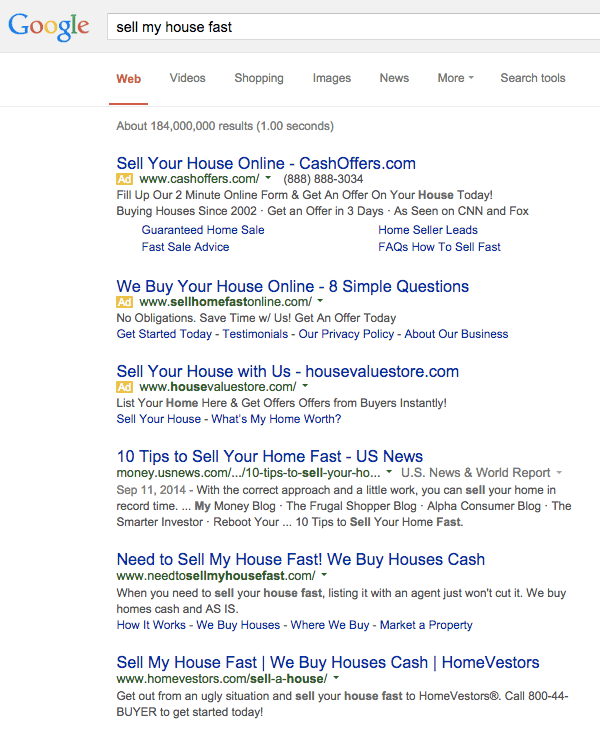
Google hasn’t learned how to build in location based results for non-location specific searches that are important to real estate investors.
Or a phrase like “we buy houses in Eugene, Oregon“. That’s a location specific search.
To help you take advantage of “local SEO“, here are 6 simple tips to master location-based SEO on your real estate investing website:
1. Be As Specific In Your SEO As Your Audience Will Be In Their Search
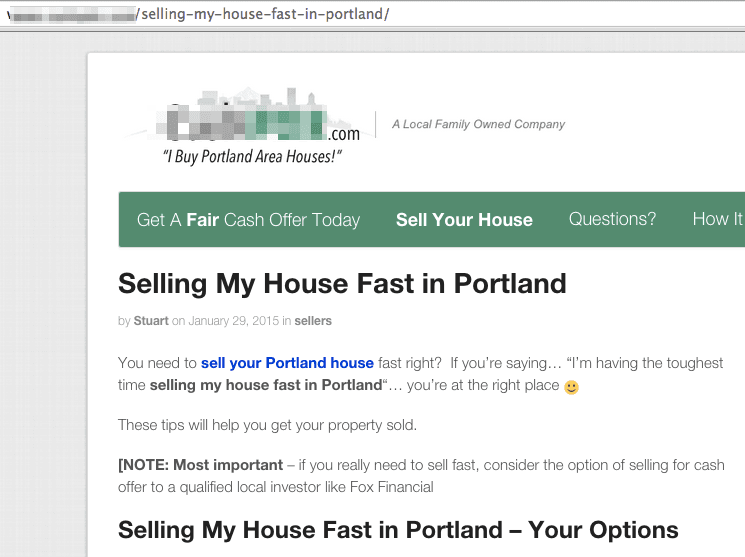
A Location Specific Page… this page ranks very well in the Portland market and is starting to pull in some leads now. We got it there by building out pages for each specific city / market he buys houses in, optimizing them, and letting the SEO gods do their thing.
One investor I worked with wanted to improve his local SEO.
I asked him what location he served and he gave me the name of the county he worked in. I asked him if his prospective home sellers would search for the name of that county when looking to sell their home.
It was an “aha!” moment for him when he realized that they would more likely use the name of their city – not the county – to find the information they were after.
NOTE: We base all of our lead generation decisions on data. So in some areas, people do search by county… most they don’t. Just get to know the ways that house sellers, buyers, tenants, etc. talk about the area they live in. If they use “Berks County” to refer to their area all of the time… it may be a good idea to setup a page optimized for the county as well.
2. Consider Multiple Pages – Or Even Multiple Websites – For Multiple Locations
Chances are, you serve more than one location – perhaps multiple neighborhoods, towns, or cities in your area.
Depending on the amount of business you expect to get from each one, you might consider creating multiple pages (each page optimized for a different town or city) or even multiple websites if the markets are completely different and it doesn’t make sense to keep them on the same website.
Of course it probably doesn’t make sense to create a site for every single municipality in the area you serve but you should probably focus on the major ones (at least at first).
3. Don’t Just Think Location… Think Action
A location is only part of it.
Of course your SEO should not only be built around a location but also needs to be built around the appropriate verb.
What verb is your audience searching for?
Sellers are probably using the word “sell”, tenants are probably using the word “rent”, and buyers might be using words like “buy” or “invest” (depending on what kind of buyers they are). Creating a location-based SEO strategy needs to include the right location but also the right verb for the people you’re reaching.
In fact, our research has shown that for every category of lead the average real estate investor is looking for (motivated sellers, cash buyers, tenants, lenders, etc.)… there are just a handful of “verbs” that those prospects are going to Google to search.
4. Extend Your Local SEO Beyond Your Website
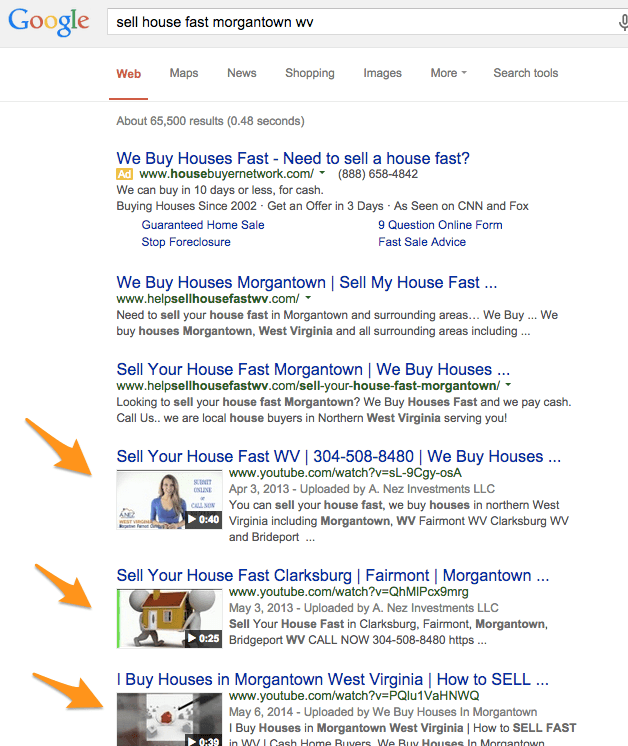
The same investor dominating the top 5 results in Google… This investor is dominating the top 5+ results in Google for this location-based search phrase in his market. He got his site ranked #1 and #2, then turned on the afterburners by optimizing Youtube videos for the same location-based search phrases.
Although you should optimize your website with location-based SEO, it shouldn’t stop there.
Use a service like Google My Business to help you place your business on a map, just as the real estate agents in the first picture above did.
And it shouldn’t stop there.
You can apply the same strategy to other sites and accounts, including Twitter, Facebook, LinkedIn, Google+, Instagram, Pinterest and more.
Each of these sites is an opportunity to create some location-based SEO. (For example, if you specialize in selling homes in Chicago, you may consider a Twitter handle like @BuyChicagoHomes.
Optimizing your Youtube videos for those local SEO terms your prospects are typing in will help you get in front of the people that matter… the people you can actually do business with and help.
5. Extend Your Location-Based SEO With Additional Differentiation
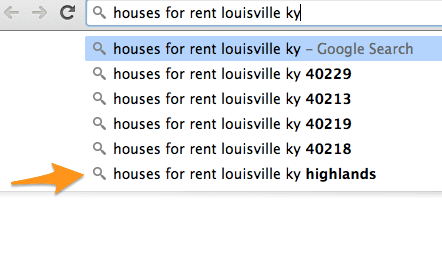
People are searching by neighborhood sometimes… In this quick search I did in Google, you’ll notice the suggestions Google gives me.
Notice in the picture above the suggestions Google is giving me.
Those suggestions are based on Google’s search data… and enough people type those phrases each month to matter.
So if you had a house for rent in the Highlands… I’d create a page on your website optimized for that very hyper-specific local SEO phrase… plus I’d also spin up a Youtube video for that phrase.
In highly competitive markets, you’ll need more than just location to differentiate.
If you work in a highly competitive market, then simply optimizing with location-based SEO alone might not be enough. You may need to become even more granular in your location (drilling down to the neighborhood instead of just the city) or add something else to your Unique Selling Proposition (USP) to help you stand out from the crowd.
You’d be surprised how specific some web searchers are getting in their searches.
6. Make Sure You Have A Call To Action!
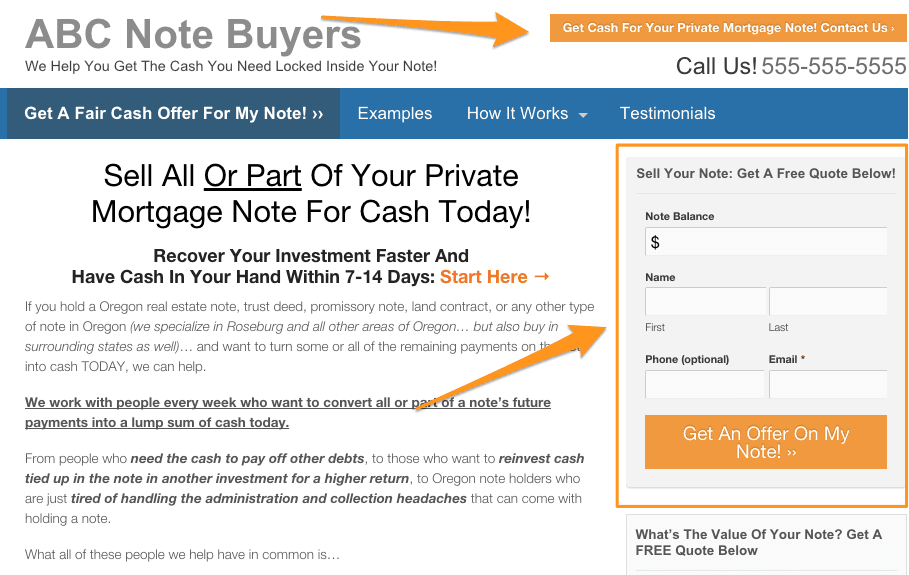
Notice on this note buying website the multiple crazy clear calls to action? These are on every page on the website…
Location-based SEO is an indicator that someone is ready to do business.
They’re highly targeted.
And in the area you can actually help them.
A home seller who wants general information about the idea of selling their home might search “how do I sell my home for cash?” but that same seller will be more likely ready to act when they to search “how do I sell my Chicago home for cash?”.
So make sure your website is structured in a way that it will convert a visitor into a lead… and a deal well.
Get Started Now To Master Location-Based SEO On Your Real Estate Investing Website
As an investor working within today’s web environment, your best strategy to gain the attention of prospective clients in your market is to use location-based SEO.
16 Point Real Estate Investor Website Conversion Rate Checklist 30 Jun 2015 5:00 AM (9 years ago)
There are two core elements to generating qualified leads online for your real estate investing business.
Whether you’re a wholesaler, flipper, buy and hold investor / landlord, rent to own, note buyer, even self-storage… the lifeblood of your online lead generation hinge on these 2 elements.
- Traffic – Getting qualified people to your website
- Conversion – Getting as many of those qualified people who need your services to engage in your website by entering their information or calling you on the phone
Both elements are a big deal because you can have all of the qualified traffic in the world, but if your real estate investing website’s aren’t converting well… you’re leaving tons of money on the table.
And if your website is the best converting thing since sliced bread… but you don’t have any qualified people visiting your website, it’s almost like keeping a Ferrari in the garage and not letting it hit the road and do what it does best.
In today’s post we’re going to run through some examples of ways you can boost the number of leads you get with your real estate investing websites without having to generate any more traffic. Now, this is assuming you’re already pulling in a consistent stream of qualified leads.
You can also download a simple checklist that you can save on your computer or print off as a handy reference when you’re making these changes on your website.
7 Of The “16 Points To Check Off” To Boost The Performance And Leads On Your Real Estate Website
Here 7 of the 16 points to check off as you’re building or optimizing your own real estate websites to convert more qualified visitors into leads. Some of these may seem obvious, but sometimes the seemingly simple tweaks can make the biggest difference.
Download the full 16 Point Conversion Checklist on this page below.
1. Put Your Main Call To Action Clearly On Every Page Of Your Website
Most real estate investor websites just have the phone number at the top of the website and the form for motivated sellers or cash buyers (or in this case note sellers) to opt in just on a few pages. Usually on their home page, a squeeze page, and maybe another one.
But we’ve found it works best to include a way for your website visitors to convert into a lead on every page… just a click away. This way they don’t have to look far to take that next step on your website when they’re ready.

Put Your Main Call To Action On Every Page: Notice on this note buying website the multiple crazy clear calls to action? These are on every page on the website…
2. Have A Clear Benefit Oriented Headline On The Top Of Your Homepage And Main Landing Pages
Many websites we see that rank high in Google have done a great job ranking well… but then they totally fall flat when it comes to converting the visitor into a lead once they get one.
One big reason we see time and time again is they fail to show the visitor exactly how they can help them within the first 3 seconds of the visit. Be sure to add a very clear benefit oriented headline that tells the visitor the benefit they’ll get by working with you.
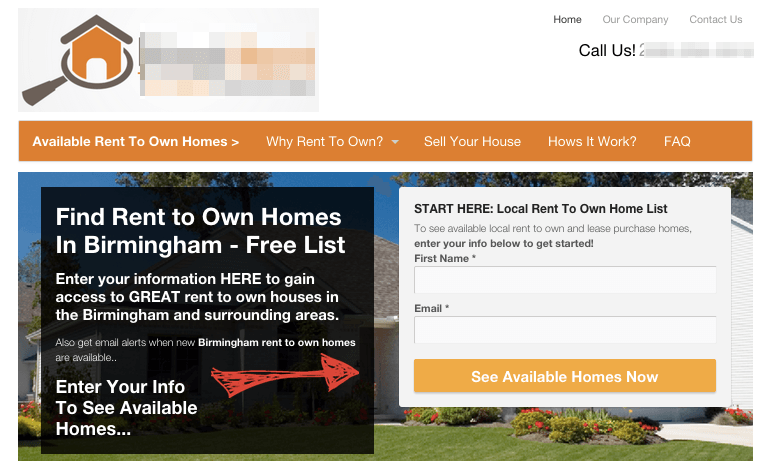
Ask yourself, “What is it that my prospect actually wants?”… then give them that in your web page headline. In this case, the rent to own tenant doesn’t want a free report, they want to see a darn list of houses. So give them that benefit and lead them to the opt in form to get it.
3. Use Color And Contrast To Help Your Call To Action Area Stand Out
Just like with your direct mail, bandit signs… and heck, even stop signs on the street… contrast attracts the eye.
A mistake many real estate investors and agents make is that their call to action buttons on their website blend in with the background of the website.
Take these 2 websites below as an example. Notice how the eye is naturally drawn to the action area on the page with the one on the right. The contrast with the Orange color and different background on the form draw the eye there. On the website on the left, the button is the same color as the opt in box… which is the same color used throughout the rest of the website. They blend in and the eye is instead drawn to the lady’s face on the left side of the screen.
If they add some contrast to that “submit” button so it stands out on the page, it would likely provide a small boost in conversion on the page.
Also, our tests have shown that making the opt in button have a benefit in it rather than “Submit” can boost conversions dramatically. (In this case, over 40%)

4. Ensure Your Phone Number Is At The TOP and Bottom Of All Of Your Web Pages And “Tap To Call” On Mobile Devices
 When we dig into our data over on our sister site InvestorCarrot, we often find some really interesting things.
When we dig into our data over on our sister site InvestorCarrot, we often find some really interesting things.
One of the latest trends has been how important the mobile experience is for someone landing on your website. 40%+ of the leads our members generate each month come from mobile devices… but 25-35% of the traffic each month is on mobile devices. That’s a disproportional number of our leads coming from mobile devices. Why?
Because we’ve engineered a great mobile experience on our platform for motivated sellers, cash buyers, tenants, etc… and 9 out of 10 websites our members are competing with online have terrible mobile experiences.
So make sure your phone number is at the top of the website, your menu and logo are shrunk down so they don’t take up much space, and your call to action / opt in box are no more than a half swipe down the page for the mobile visitor.
5. Add Credibility Badges On Your Website
I wouldn’t suggest this as one of the first things you’d do, because there’s other more “low hanging fruit” as far as getting conversion bumps that you can do.
But in every test we’ve ran where we added a credibility badge like a BBB logo on the website… and not just on the website but at the top of the website above or just next to the main call to action form, we’ve seen an increase in the conversion on the page.
Why?
People are skeptical by nature and we look for cues as to the trustworthiness of a website. Since the BBB is a widely recognized brand and trusted source, seeing that on your website gives that warm and fuzzy feeling that you’re a safe company to do business with.

Nearly 10% More Leads From Building Trust With The BBB… This company is a client of ours at our Enterprise level (only for companies that do at least 80+ deals a year already) and they had their BBB badge on the site, but it was further down. We moved it to the top and saw an immediate boost of almost 10% more leads.
6. Don’t Ask For Too Much Information Right Away. Reduce Your Initial Form To 3-4 Form Fields Ideally
In our tests and other tests outside of the real estate industry, test after test has shown that the more form fields you ask your visitors to fill out, the lower the conversion rate.
Now you may be saying, “Ya, but the more form fields the more qualified the leads too!”
And you’d be 100% correct.
But in our tests, we’ve found that there’s the highly motivated lead who will fill out the form whether it has 4 fields on it or 8… but there’s also the “on the fence” leads that wouldn’t fill out a longer form but will “dip their toes” in on a shorter form first.
Then we pass that lead to a longer “2 step” form immediately where we’ll further qualify them. There’s a psychology term called Commitemnt and Consistency where us humans are hard wired to follow through on bigger commitments after we’ve made small ones. Our 2 step opt in process with 3-4 form fields on the first form and then the longer form on the second step convert more leads on the front end and end up getting more people to further qualify themselves on the 2nd step than if you were to ask for more information on the first form.
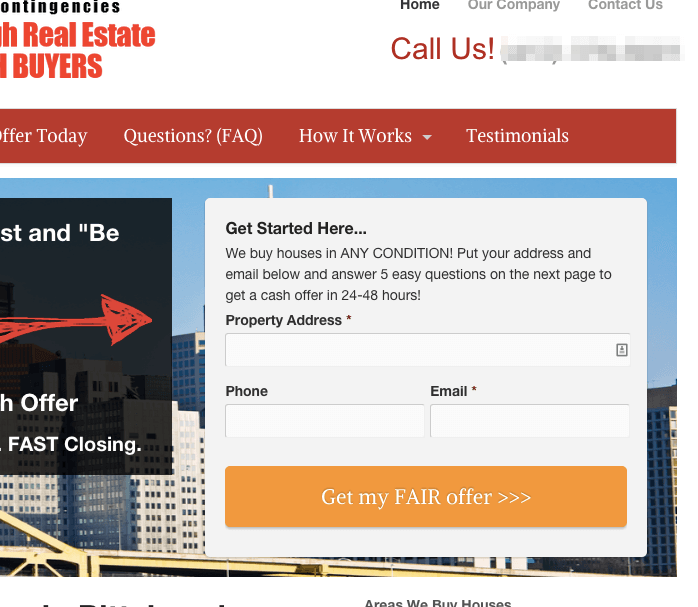
Make it easy for your cash buyers, sellers, tenants, and lenders to engage on your website. It can be intimidating to make a seller jump through 10 form fields on the first step. Make it easy on step 1 to get their info, then further qualify them on step 2.
7. Show Website Visitors You’re Real People Behind The Company
Many of your website visitors may be skeptical before they even land on your website. Motivated house sellers may have heard about the “house flipping scams” on the news (that of course have nothing to do with how you run your business) and project that fear on every house buyer they come across.
The same goes for selling investment properties. Too many people list bogus houses on their websites or they don’t ever list any at all and are building a cash buyer list without taking any real action to get any properties on the site… and it can breed skepticism.
One way to combat that is to connect with your website visitors on a more personal level.
Show them you’re a real person behind the company.
According to a Stanford study called the Stanford Web Credibility Research study, several of the top 10 ways to increase the credibility of your website involve you just opening up and showing you’re real.
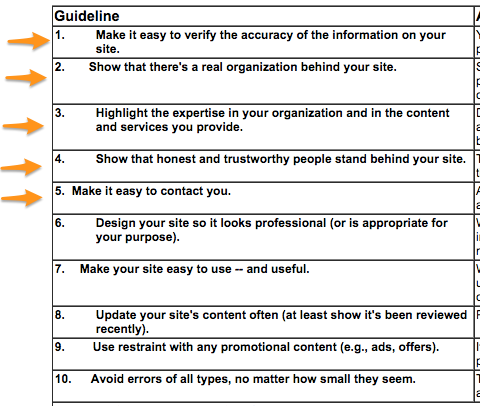
Stanford Web Credibility Research Results: The orange arrows point to the credibility elements that involve you making it easier to connect with you as a person. It matters.
You can do this by…
- Building out a simple about page that has a picture of you / your team and what you stand for
- Making it easy for people to contact you
- Show that you have the expertise to help them (testimonials are amazing validators of your expertise)
Just get creative and connect with your website visitor on your website the same way you would in person.
Download The Rest Of The 16 Carrot Conversion Points Checklist Below!
I hope you have at least 1 or 2 things you can implement in the 7 real estate website conversion tips above.
We’re continually testing and improving the effectiveness of Inbound Online Marketing websites for investors and agents so our members can focus on what they do best.
Feel free to share this with your colleagues and implement some this week!
Download 16 Conversion Tips Checklist
7 Youtube SEO Optimization Tips For Real Estate Investors & Agents 23 Jun 2015 7:00 AM (9 years ago)
Do you see your competition ranking their Youtube videos at the top of Google for the search terms you want to rank for?
Like This?…
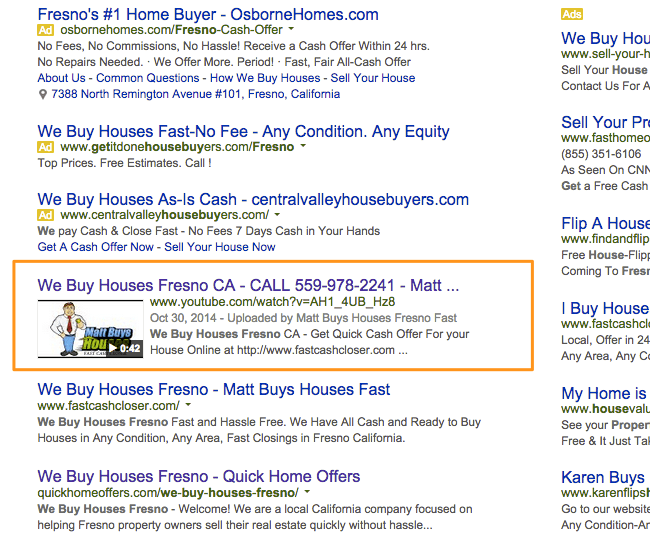
This is a screenshot of a popular motivated house seller search where our InvestorCarrot customers control the top 3 positions in Google. The #1 position is a Youtube video. Learn how to boost your Youtube video marketing below!
In this post we’ll show you some Youtube SEO optimization tips that you can implement in your real estate investing or agent companies.
The short-term things are actions you can take to get visitors to your website (cash buyers, motivated house sellers, tenants, private lenders, note sellers, etc.) within the first 30-60 days while your long-term SEO campaigns build.
One of the marketing tools we love the most for both our short-term and long-term lead generation for ourselves and our high achieving investor clients is Youtube marketing. We wrote a short post about it last year, this post is a more detailed followup on optimizing those Youtube videos.
Infographic: 7 Youtube SEO Optimization Tips To Implement On Your Youtube Videos This Week

The Biggest Youtube Video Marketing Mistakes Real Estate Agents And Investors Are Making Every Day
The reason Youtube videos can rank so darn fast is because of the “Domain Authority” of Youtube.com.
In Google’s eyes, Youtube has the highest possible authority and trust that a website can get.
This makes it so any video uploaded to Youtube automatically has a better chance of ranking quickly for search phrases that it may take you months and months to rank well for with your own website with SEO.
The ROI of Youtube marketing as a house flipper, investor, or agent can be pretty huge for the time you’ll invest. An average wholesale deal could net you approx $5k on the low end right? Would 3-4 hours of video work and “seo boosting” be worth it for that profit potential? The same for agents… what is your average listing worth?
But you only have a better chance if you implement what the graphic above shows and avoid these common mistakes we see investors making.
Avoid…
- Not using your main keyword phrase in the video title: Most investors will throw a video on Youtube and not really think much about the title. If you want to rank well for “sell my house fast madera CA”… your video should have those words in it toward the start of the title.
- Not uploading enough videos to your channel: Every day we see people asking how to improve their Youtube video rankings… then we look at their Youtube channel and see only 1 or 2 videos in there. Google wants to see that a channel is active. So get at least 4-6 videos in there!
- Not typing up a good long description in the description box: People forget that Google can only read what we give it to read. So use that description area to really talk about the content in the video. Include your keyword phrase and variations of it… and ideally get your keyword phrase toward the start of your description. Treat the description box like you’d treat the content on a page on your lead generation website. Get good quality content on there and optimize the content for the phrase you’re wanting to rank for.
- Not linking to your website from your description with the full “http://www.yoursitehere.com”: A solid way to drive people to your website and get a link back to your website is to include a clickable link in your video description! It’s a no brainer and should be one of the first things you put on your description.
- Thinking your work is over after you upload your video: If you’re in a competitive market where lots of other real estate investors, wholesalers, flippers, agents… etc. are competing for the same search phrases… you may need to add some SEO “boosters” to get your videos to rank higher. Get people to comment on your videos, share it on social media, link to the video, and post the video on your own website too. You’d be surprised how easy ranking a Youtube video can be with a few of the right steps.
The Content Marketing Pyramid For Real Estate: More Results With Less Work 17 Jun 2015 9:33 AM (9 years ago)
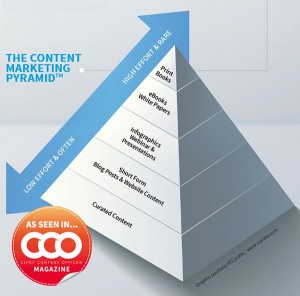 Content marketing has been around as long as marketing has been around.
Content marketing has been around as long as marketing has been around.
And that’s a LOOOOONNNNNGGG time.
In fact, back before the internet, TV, radio, telephone, newspapers, and the USPS… content marketing was about all there was to sell your wares. You had some chickens, you were there in the market talking up why your chickens were so great and maybe even giving them a “taste” of it to reel them in.
Content marketing is giving people a “taste” of your best stuff and the value you can give them… in hopes of building that trust so the customer decides to do business with you.
But just over the past 5 years, it’s really caught on in the online marketing world. There are 2 big reasons content marketing works so well and is getting more popular.
First, Google loves great content…. and websites that update content often.
Second, with so many websites online today… content is a great way to differentiate yourself from your competitors
But the same issue has existed with Content Marketing, especially for real estate investors and agents that holds most people back from doing Content Marketing effectively as a part of their inbound online marketing strategy to pull in more real estate investing leads.
How To Write Effective Content With Less Effort?
The 2 main roadblocks that real estate investors and agents tell us are stopping them from doing more Content Marketing are…
- The time it takes them to write content
- How to decide what to write about
We’ll help solve both of those for you in today’s post.
So in this blog post we’re going to introduce you to the Content Marketing Pyramid to help you create more content with less effort (and make that content actually pull more traffic and leads for you that your competitors likely aren’t even going after)
The Content Marketing Pyramid: For Real Estate Investors
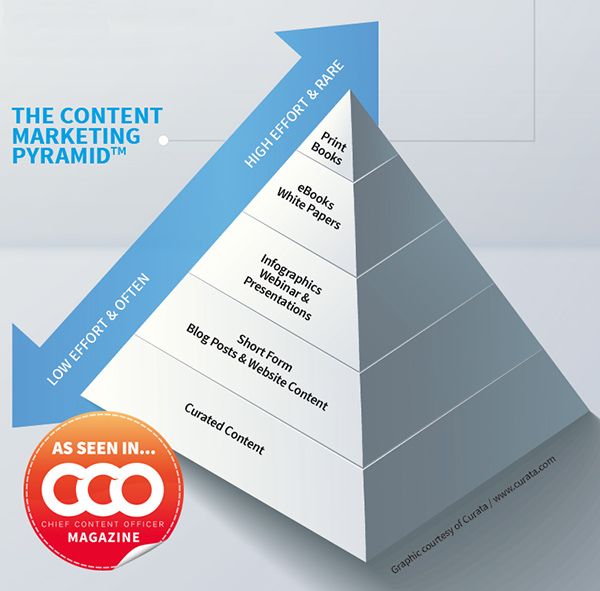
The Content Marketing Pyramid will help you shift your mindset around content marketing from, “It’s too hard and I don’t have enough time” to “This is much easier than I thought!”
Why The Content Marketing Pyramid Can Be Magical To Your Content Marketing Strategy
When I got started really learning how to drive traffic to my websites I started the same way everyone does.
I threw up a few blog posts… with no strategy at all… thinking people would miraculously land on the blog post and become a customer.
It doesn’t happen that way.
Every blog post I put on the website took me 2-3 hours to write, edit, and publish… and I thought I had to come up with unique real estate investing articles every week that I wrote from scratch.
It was a lot of work.
So I got discouraged pretty darn quickly because it was so darn time consuming, it was hard to come up with topics to write about that I thought were worth writing about from my brain, and I’d always end up quitting a couple months in.
Until I adopted a strategy similar to the content marketing pyramid above.
Here’s what following this framework for your content marketing for your real estate business can do for you.
It Helps You Easily Generate Effective Content For Your Real Estate Website That Positions You As The Expert
This post you’re reading right now is actually using a part of the content marketing pyramid.
The easiest way to come up with great content ideas is to get inspiration from other places.
That’s why I really love (but don’t use as often as I should) the bottom of the pyramid… “Curated Content“.
The Content Marketing Pyramid came from someone else’s website. I loved the concept and we decided to use it as inspiration for our own blog post (giving credit to Chief Content Officer Magazine).
You can get inspiration for your own content from lots of sources. Like BiggerPockets, our website, Inman News, Zillow, your local news websites… really anywhere.
I’ve seen blog posts that literally just took an infographic from another website, posted it, wrote a few sentences that were optimized for a keyword phrase they wanted to rank for… and they were able to grab a quick easy ranking with some great simple content.
Total time investment… maybe 15 minutes.
I suggest you focus on the bottom 2 sections of the pyramid…
- Curated Content (where you find content on other sites, use it as inspiration on your own website and give them credit)
- Unique Blog Posts And Pages (where you write more of that content from scratch or even use something else as inspiration like this post)
The rest of the pyramid is for the more advanced Content Marketer.
It Helps You Simplify Content Marketing In Your Mind
Too many real estate investors don’t want to put in the work to be successful.
They want to take the easy route… which I can tell you from personal experience, there isn’t an “easy” way as an entrepreneur.
But when it comes to content marketing, most real estate investors and agents immediately jump to the conclusion that it has to be tough and require a lot of work.
When you follow the pyramid and focus mainly on the bottom two sections, curating and summarizing other great content (60-70% of your content), and writing simple blog posts (30-40% of your content)… it really simplifies the process.
If you were going to write a blog post a week on your real estate investing website, here’s what I would do.
- Week 1: Curate and summarize an article in your own words from a local news station or blog’s real estate or financial section. 15-20 mins.
- Week 2: Write a blog post that answers a common question that your prospect thinks or asks. 15-30 mins.
- Week 3: Curate and summarize an article, youtube video, or an infographic you find in Google images 15-20 mins.
- Week 4: Curate a local news story in your area and tie it to a “hook” that resonates to your prospect. 15-30 mins.
We’re talking about a couple hours a month.
Everyone has a couple hours a month. If you don’t, you should think about cutting back on your cable TV or Facebook time ;-).
Content marketing done right is all about delivering value to your prospect and optimizing it for phrases that your prospects are typing into Google.
It’s not about being the best writer or having the most unique ideas.
Look at websites like the Huffington Post.
The majority of their articles are “curated” from other news sources that put the news story out first. They just gave it their own little twist and summary to the topic and posted it on their website.
So what’s the next step you should take? Get some content marketing going on your real estate websites this week!
Follow the Content Marketing Pyramid and let us know how it goes!
